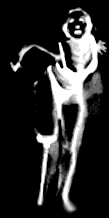May 10, 2007
Wafaa Bilal: Domestic Tension
Iraqi born artist Wafaa Bilal has become known for provocative interactive video installations. Many of Bilal's projects over the past few years have addressed the dichotomy of the virtual vs. the real.
He attempts to keep in mind the relationship of the viewer to the artwork, with one of his main objectives transforming the normally passive experience of viewing art into an active participation. In Domestic Tension, viewers can log onto the internet to contact, or shoot, Bilal with paintball guns.
Bilal’s objective is to raise awareness of virtual war and privacy, or lack thereof, in the digital age. During the course of the exhibition, Bilal will confine himself to the gallery space. During the installation, people will have 24-hour virtual access to the space via the Internet. They will have the ability to watch Bilal and interact with him through a live web-cam and chat room. Should they choose to do so, viewers will also have the option to shoot Bilal with a paintball gun, transforming the virtual experience into a very physical one.
Bilal’s self imposed confinement is designed to raise awareness about the life of the Iraqi people and the home confinement they face due to the both the violent and the virtual war they face on a daily basis. This sensational approach to the war is meant to engage people who may not be willing to engage in political dialogue through conventional means. Domestic Tension will depict the suffering of war not through human displays of dramatic emotion, but through engaging people in the sort of playful interactive-video game with which they are familiar.
For the duration of May, 2007, Iraqi born artist Wafaa Bilal will live in the FlatFile Galleries in Chicago. The public can watch him 24 hours a day over a live webcam; and if they choose, visitors to his website can shoot him with a remote controlled paintball gun.
Bilal’s self imposed confinement is designed to raise awareness about the life of the Iraqi people and the home confinement they face due to the both the violent and the virtual war they face on a daily basis.
You can participate - eg shoot at him with a paintball gun - by clicking here.
See this site for some videos and more about the Wafaa's work. [via selectparks]
Posted by jo at 03:29 PM | Comments (0)
February 24, 2007
Do It With Others (DIWO): E-Mail-Art at NetBehaviour

A Collaborative Exhibition at HTTP Gallery, London
Hi DIWOists,
The Furtherfield crew has been discussing ways to get the most out of the co-curating session on Sunday when we will discuss and experiment with ways of exhibiting the contributions at HTTP gallery (don't forget the opening is next Thursday).
Other known contributors to this process in the gallery on Sunday are Frederik Lesage and james[at]jwm-art.net, others are welcome. Please check back with the list at 1.30 on Sunday for details of thewebcast and public chat room where you can join the discussion online. Until then you can view a gallery floor plan and tech spec here.
So here is a summary of our considerations, proposals and a number controversies for your feedback!
CONSIDERATIONS:
1) How to Survey the Contributed Materials for the Curation Process: There have been over 600 posts to NetBehaviour since the start of this project and we have 2-5pm on Sunday to review and discuss how to present contributions. The main ways that we have for looking at work is:
- through our mailboxes
- through an index of attachments that can be view browser here
Your Suggestions Please: We would like your suggestions for any other (reasonably straight forward) way to order materials for review.
2) Categories - How to Order and Discuss Materials.
It would be useful to have some broad themes or categories to discuss. Here are a couple of possible categories with examples (and these really are just examples) of what we mean.
- Threads - discussions, exchanges, actions and responses eg Sachiko Hayashi's 'The Other Half',
- Collaborations and remixes eg RandomLab's reblogging and remixing, Michael Szpakowski's remix of Thomson and Craighead's 'Additions' image
- Digital becomes Material eg Sim Gishel has sent a 'Will Work For Food' vehicle, brian[at]netartguy's currency could be laser-printed as actual currency, Other works proposed for print, Other works actually sent to HTTP etc
- Proposals/ Instructions- eg Ant Scott's installation proposal, Glorious Ninth's Love Potions
- Generative/machine Art- eg. Sim Gishel's data-mining, ARN's generative pngs
- Stand alone streams - movies, soundfiles and images eg images by Clive McCarthy, lem urtastic - movies by Lizzie Hughes, Alan Sondheim - mp3s by james[at]jwm-art.net
- Texts eg Janedepain's recent 'Poetic Terrorism and Guerrilla Art in the 21st Century' and technical discussions.
PROPOSALS:
1) We propose that the main projection consists of a Mailbox containing a DIWO archive for searching by gallery visitors. This would be organised into themed directories that would coincide with the categories listed above. PLEASE SUGGEST: more or other categories.
2) We propose that we highlight and exhibit some 5-8 works (made by individuals or collaboratively) in the form of objects, printouts, projections and sound. These would be up for discussion and debate from this point - to be decided on Sunday.
CONTROVERSIES:
1) The question of selection - how do we create an exhibition in a physical space that communicates the DIWO spirit?
- how do we highlight a selection of works?
- how do we stay true to the open principle of including all submissions?
2) Contextualisation
- do some works need contextualising in order to be accessible to gallery visitors eg should some works be displayed with titles, artist, date, materials, description of process etc?
- if so how, and who does it?
3) Is everything that has been posted to NetBehaviour since February 1st considered a submission to DIWO?
- including announcements and reblogging?
4) A number of people have proposed works in private emails to Marc or myself- should these be included under the rules of submission?
Whoever wants to contribute to the curation of this show- share your views here on the list or come along on Sunday ttp://www.http.uk.net/DIWOcurating.shtml
Let's DIWO!
: ))
Ruth [via netbehaviour]
Posted by jo at 12:01 PM | Comments (0)
September 20, 2006
International Airport Montello
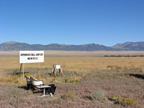
eteam CAUSES EXTENDED LAYOVER at IAM
eteam CAUSES EXTENDED LAYOVER at IAM :: International Airport Montello :: On Friday, September 15, 2006, an 8-passenger Beechjet 400 of AiG Airlines was on its way to Las Vegas for a weekend of art and gambling, when the pilots received a radio call about a sand storm in Nevada causing an unexpected 8-hour layover at the International Airport Montello (IAM).
Fortunately, IAM was prepared. The terminal’s food court and services were ready to serve, including the five star Juan’s Coffee Shop, the VIP Sky View Dinner Club, the Cowboy and Saddle Sore Bars. And IAM employees welcomed AiG Airlines passengers and other layover tourists with the utmost attention. Adventurous travelers and unique characters were among the passengers who were stuck at the IAM, adding to the distinctiveness of this layover. Despite that the IAM kept its air conditioning at extremely low temperature and its fans at high speed it was the perfect airport to experience an extended layover.
The International Airport Montello (IAM) is a project done in collaboration between the Brooklyn-based artist’s collective known as eteam and the citizens of Montello in Nevada. It takes place around a 10-acre piece of land purchased by eteam from an auction at eBay.com for less than $500 dollars. IAM consists of a series of recurring events in or about an abandoned airstrip—that is approximately 6000 feet and located nearby the eteam’s land—in order to reignite its use or potential.
During the summer, in a program at the New School’s Vera List Center for Art and Politics with writer Jeffrey Kastner and Matthew Coolidge of the Center for Land Use and Interpretation, eteam presented IAM to New York audiences. Weeks later, curators Jeffrey Walkowiak and Rachel Gugelberger of Sara Meltzer Gallery helped eteam turn that gallery’s penthouse into an airport gate, where passengers waited for hours to catch a plane that never came. Before the layover, IAM hired the Brooklyn-based artist and writer Jason Dean as one of its Layover Crewmembers, who together with eteam was present at the layover. In October, and thanks to park ranger Linc Hallowell, eteam will use the runways of Floyd Bennett Airfield in New York City to connect to the middle of nowhere where IAM operates.
These events, including the layover, are part of the eteam’s art project IAM, which will culminate in an exhibition at Art in General opening on January 27, 2006. The IAM wiki-website is created and administered by eteam and the citizens of Montello: www.internationalairportmontello.com
The International Airport Montello by eteam and the citizens of Montello is commissioned by Art in General. The website component of the project is co-commissioned by Art in General and the Digital Matrix Commissions of Longwood Arts Projects in New York.
Posted by jo at 11:33 AM | Comments (0)
September 01, 2006
etoy.CORPORATION

MISSION ETERNITY at Burning Man 2006
August 29, 2006 8:22:21 AM GMT+02:00: BURNING MAN FESTIVAL 2006 - etoy.AGENTS braving the desert nights, sand in our teeth, resolve in our red eyes. WELCOME to all new M∞ PILOTS! :: As of today, etoy.CORPORATION presents the MISSION ETERNITY SARCOPHAGUS, a mobile sepulcher for users who prefer to be buried at an undetermined geographical location, at the Burning Man 2006. Check us out near the temple (open after sundown), or visit the etoy.CREW at the playaQ camp site at 4:30 and brave!!!
The mobile cemetery tank is a 20 foot ISO standard cargo container which potentially travels planet earth forever. The inside walls of the tank are covered with 12,000 individually addressable LED pixels, forming an immersive, semi-interactive display system with each pixel offering a last resting place of a M∞ PILOT. The system therefore allows for simple re-location of the mortal remains of up to 1000 M∞ PILOTS.
YOU ARE INVITED TO JOIN MISSION ETERNITY - ONE OF THE MOST CHALLENGING OPEN CONTENT PROJECTS IN THE HISTORY OF ART. STORAGE ANGELS, CODERS, LAWYERS AND MORTAL REMAINS COURIERS CAN APPLY ONLINE FOR ANGEL STATUS AND PARTICIPATE IN THE MISSION. http://www.missioneternity.org/angels
Visit http://www.missioneternity.org for detailed project documentation, software download, and initiation protocols. To support MISSION ETERNITY contact invest[at]ir.etoy.com
COMMUNICATION: Due to extensive offline operations in LA, some etoy.AGENTS missed considerable amounts of emails, phone calls and other data traffic. Please visit http://www.etoy.com/ contact and resend your messages to specific agents if you did not get the answer you were looking/waiting for. The etoy.CREW apologizes for the communication inconvenience.
Posted by jo at 03:09 PM | Comments (0)
August 30, 2006
Open Burble
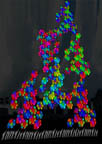
A Combination of the Crowd's Desires + Turbulence
bur.ble n.: 1. A gurgling or bubbling sound, as of running water. 2. A rapid, excited flow of speech. 3. A separation in the boundary layer of fluid about a moving streamlined body, such as the wing of an airplane, causing a breakdown in the smooth flow of fluid and resulting in turbulence.
In Open Burble, a crowd of participants designs and constructs a "burble" that rises towards the sky like a plume of smoke. The project came about because we wanted to find a way to use the technology developed for Sky Ear in a more intuitive way that enables people to engage directly with the tactile experience of flying the cloud.
Participants will divide into groups in order to assemble about 140 hexagonal "clouds" into a complete Burble, built to such a scale that, when inflated with helium, it will soar upwards like Jack's beanstalk. Just as the participants are the generators of the Burble's 60m tall form, so too are they the ones to control it. They hold on to it using handles with which they may position the Burble as they like. They may curve in on themselves, or pull it in a straight line - the form is a combination of the crowd's desires and the impact of wind currents varying throughout the height of the Burble.
The Burble will move, rustle, tangle, fold in on itself and create turbulence as the wind catches it like a sail. Suddenly, the entire construction will ignite with colour, sparkling in the evening sky. As people on the ground shake and pump the handle bars of the Burble, they will see their movements echoed as colours through the entire system. They will see their own individual fragments, perhaps even identifying design choices they have made. Their invididual contributions will become an integral part of a spectacular, ephemeral experience many times their size that they have come together to produce. [via Interactive Architecture dot Org]
Posted by jo at 08:33 AM | Comments (0)
August 24, 2006
Improv Everywhere
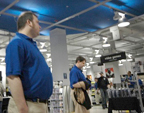
Operation Best Buy
Improv Everywhere is a group of agents (pranksters) based in NYC who organize missions (happenings) in public space. Their intent is to bring excitement to otherwise unexciting locales and give strangers a story they can tell for the rest of their lives. One of the group's latest missions took place in a Best Buy shop and was carried out by more than 80 agents.
The group met at a Best Buy shop all wearing blue polo shirts - almost identical to the store's uniform - where after they entered the shop and began circulating. They did not claim to work at the shop, however when a customer mistook them for an employee, they did their best to help out...Extensive documentation is available online. [blogged by Sebastian Campion on Guerrilla Innovation]
Check out Cell Phone Symphony, Suicide Jumper, and lots of their other missions.
Posted by jo at 12:30 PM | Comments (0)
August 17, 2006
LOCUS SONUS
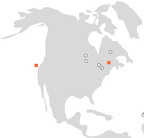
DUPLEX PERFORMANCE
THE THING invites your face and body and voice to 11 Harrison Street, ground floor storefront gallery, RIVERFAWN, for the Manhattan interface of THE THING.residency: LOCUS SONUS DUPLEX PERFORMANCE. This is a special performance that will be live from the Roebling Bridge on the Delaware River and from the RIVERFAWN Gallery in New York City. You will be part of the performance! :: 6pm –10pm Thursday August 24th :: 11 Harrison Street, ground floor* :: New York City.
Locus Sonus has constructed for this performance 2 IP webcams/parabolic microphones with which they can hunt for sounds in and around the venue streaming them simultaneously to the remote location. In each location laptop performers capture and remix the audio from the mic and video projectors show what the mobile microphones are capturing. Both mixes are played in both locations, the musicians responding to their remote counterparts. The Roebling Bridge will be set up on both sides of the river (the audience will be on the bridge). The idea being that we can use the local distance to reflect the remote distance. On the Manhattan side, the performance will take place in the RIVERFAWN Gallery where they will also use the wire/stream interface as an instrument to mix and control during the presentation. Live sounds from around the world (from the locusonus open web mics project) will also be used as raw material for the concerts.
Locus Sonus will be in residence between the 15th and the 29th of August in the USA with two installations and a duplex performance between them. The two locations will be at the DIGIT Festival, Delaware Valley Arts Alliance & Roebling Bridge Environmental Arts and at the RIVERFAWN Gallery in New York City.
DATES: The Installation at the Delaware Valley Arts Alliance opens on Saturday, August 19th and runs until August 25th. The performance Duplex Roebling Bridge/Manhattan will take place Thursday, August 24th at RIVERFAWN Gallery, 11 Harrison Street in New York City. There will also be a physical installation/interface on view from August 22nd to the 27th, 12-6pm at RIVERFAWN Gallery.
For more information: http://nujus.net/~locusonus/site/index_e.html
Audio streams: http://nujus.net/~locusonus/site/documentation/allstreams/index_e.html
ABOUT LOCUS SONUS
Locus Sonus is a research group specialized in audio art (École Supérieure d'Art d'Aix-en-Provence, École Nationale Supérieure d'Art de Nice Villa Arson). Our objective is to experiment and evaluate the innovative and transdisciplinary nature of audio art forms in a lab-type context. We are are also concerned with the communal, collective or multi-user aspects inherent to many emerging audio practices and which necessitate working as a group. Two main thematics define this research - audio in it's relation to space and networked audio systems. The "Lab" proposes a process combining practical artistic experimentation and critical evaluation in a group context. The Locus Sonus Lab is currently focusing on a process which revolves around the use of multiple audio streams. The streams which are basically open-mic continually upload chosen soundscapes or sound environments, as playable material. The way in which we work with other people to set up and maintain the streams is part of the methodology, indeed the technology provides the basis to construct a human network.
*Directions: by subway take 1 train to Franklin Street. Walk one block west on Franklin to Hudson and cross the street. Walk 1 block south to Harrison and turn right. 11 Harrison street is in the middle of the block on the south side of the street, By car: From uptown Take West Street to Vestry. Make a left on Vestry. Go two blocks make a right on Greenwich Street. Go two traffic lights , make a left on Harrison street. From downtown take West Street to Harrison street. Make a right on Harrison and go 1 block.
Posted by jo at 09:25 AM | Comments (0)
June 01, 2006
ELIZABETH LEISTER
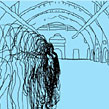
EVERY BODY IS EVERYWHERE AND NOWHERE
Every Body is Everywhere and Nowhere combines performance and technology in an immersive video installation. This new project continues Elizabeth Leister's themes of transformation and control in relation to the body. Leister's performative investigation is informed by a history of body-based performance art, including, Ana Mendieta's "Silhueta Series", "Push Ups", by Vito Acconci and "Up To and Including Her Limits" by Carolee Schneemann. Like the aforementioned, Leister uses video images of body imprints and line drawings, actual and animated, to study the physical and virtual body in space.
What occurs when the body is transformed through our use of technology? The amalgamation of video, performance and drawing in Leister's project links the traditional to the technological and emphasizes the physical impact of our bodies on the world we live in with one another. Our body language, sense of touch, corporeal presence and physical movement through space become invisible as we interact via machines. What is lost? What is gained?
Leister will perform a drawing to define her own physical borders within a specific moment in time and space. This drawing will be made each day for the duration of the exhibit in Leister's Los Angeles studio and transmitted through live-feed via web-cam, into The Morris Gallery in Philadelphia. The traditionally intimate space of performance will expand as the body of the artist is projected across space and time. Made up of shifting light and pixels traveling through cyberspace, the body becomes expansive and limitless.
A second video shows a collage of the imprints left behind by Leister's family and friends: a snow angel, footprints in the sand, a sweater tossed to the ground. A third projection of an animated drawing outlines, frame by frame, a body moving through space. Like the drawing created in the performance, lines are built up to define a path of movement, then reverse and erase.
A computerized voice expresses a desire to be everywhere and nowhere, everyone and no one while a second audio track, taken from Leister's writings, is an overlay of a human voice whispering as if she were light and breath in an unnamed space.
Finally, the video projections will be installed in relation to a set of mirrors to create a kaleidoscope of images that will reflect the body of the viewer. Through live-feed performance, drawing and video the project will juxtapose the physical body and the immateriality of the virtual body.
The exhibition in the Morris Gallery at the Pennsylvania Academy of Fine Arts opens on June 10th and runs through August 20th. The installation, which will open with a free reception June 9 from 6 to 8 p.m., is curated by Alex Baker, the Academy's Curator of Contemporary Art.
Museum hours are Tuesday through Saturday, 10 a.m. to 5 p.m., and Sunday, 11 a.m. to 5 p.m. The Academy is located at 118-128 N. Broad Street in Philadelphia, two blocks north of City Hall. Regular admission is $7 adults, $6 seniors and students with ID, $5 children / youth ages 5-18, free for members and children under age 5.
Elizabeth Leister received an M.F.A. in sculpture from the Milton Avery Graduate School of the Arts at Bard College and a B.F.A. from the Tyler School of Art. In Philadelphia, her work has been exhibited at the Philadelphia Museum of Art and Nexus Foundation for Today's Art. Her work has also been shown at the Delaware Museum of Art, the North Dakota Museum of Art, Art in General and P.S. 122 in New York, and the Kellogg Art Gallery at California State Polytechnic University, Pomona, among others. She has received awards from the Pennsylvania Council on the Arts and the Leeway Foundation.
Posted by jo at 11:06 AM | Comments (0)
Invisible Maze
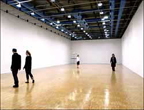
You Make It
Jeppe Hein's Invisible Maze installation is just what its title says: invisible. The promised maze is there but it only materialises as we move around in it. Visitors are equipped with digital headphones operated by infrared rays that cause them to vibrate every time they bump into one of the maze's virtual walls. Thus, the exhibition is perceived as a both minimalist and a spectacular playground. The maze structure spans six different variants, all of them referring to labyrinths from our common cultural history. From the medieval labyrinth in Chartres to Stanley Kubrick's fateful dead end from the film The Shining to Pac-Man. The maze changes from day to day, inviting visitors to make repeat visits.
Statens Museum for Kunst in Copenhagen will present Jeppe Hein: Invisible Maze 10 June - 27 August 2006. The exhibition represents a further development of the exhibition Invisible Labyrinth which attracted 50,000 visitors during its two-month run at the Centre George Pompidou in Paris last year. Via Art Daily. Thanks Joshua. Other work by Jeppe Hein: Distance.
More sound-based spatial installations: audio space + audiotag + audio graffiti, Mapamp, Sonic city, sound mapping, Aura, Akitsugu Maebayashi's audio work, Audio Viscera, electrical walks, aetherspace, etc. [blogged by Régine on we-make-money-not-art]
Posted by jo at 10:15 AM | Comments (0)
The Busycle
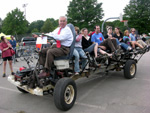
Cross Country Story Collecting Tour
The Busycle, a 15 person pedal powered bus, is taking its first U.S. Story Collecting Tour. The Busycle is a story collection vehicle. The traveling public art piece will start in Boston, and, hauled by a grease/ bio-diesel vehicle, will end in San Francisco. Between, the Busycle will visit cities and collect stories of the people who pedal it.
In cities across the U.S., the Busycle will travel neighborhoods, where anyone willing to pull their weight and pedal can be a Busycle passenger. At the end of the route, a story collection space will be constructed (in places ranging from parks to warehouses to galleries). At this temporary story collection space, everyone has the option of being a participant. And just as the Busycle doesn’t run without the pedaling, this venue doesn’t run without the contribution of stories.
It’ll be an urban play on the campfire as the traditional space for story telling and stories will be recorded on video. Stories recorded in one city will be shared in the next city, connecting the experiences and stories of the tellers and listeners. Everyone is asked to bring a blanket (and their story, if they choose) to the story collection.
The Busycle Cross Country Story Collecting Tour: WHEN: June 2006; STARTING POINT: Boston; MIDDLE POINTS: Providence, Cleveland, Minneapolis, Marquette NE, Minneapolis, Cheyenne, Salt Lake City, Reno; ENDING POINT: San Francisco; CONTACT: Heather Clark / Matthew Mazzotta, 617-721-3475, busycle[at]gmail.com
![]()
The Busycle, under development since 2005, runs solely on the energy of its passengers. All passengers are required to pull their weight and pedal in their seats. The pedal power then moves the Busycle from destination to destination. The Busycle’s public life involves experimental public rides that travel down city streets, where story telling is of the essence. It is our goal that by bringing art and technology clearly into the public realm and as near to the community as possible (what could be closer than riding an art project down the streets where people live and inviting them onto the art?), we will begin to stir a dialogue about the current and universal issues from which the Busycle has grown, while creating a forum for people to pause and enjoy.
Posted by jo at 08:42 AM | Comments (0)
April 04, 2006
TOPLAP

(Temporary|Transnational|Terrestrial|Transdimensional) Organisation for the (Promotion|Proliferation|Permanence|Purity) of Live (Algorithm|Audio|Art|Artistic) Programming
TOPLAP is a livecoding audio-visual performance group. Check their wiki for FAQs to find out such illuminating questions as: What's the difference between generative music and live coding?
DEFN 1 Generative music is created from some algorithm, usually running autonomously. There may be controls (parameters/arguments) to this process but the algorithm itself is fixed. Live coding is a way to substantially modify the actual nature of that algorithm, even as it calculates, in a realtime performance or interactive composition setting.
DEFN 2 They are kind of opposites. Generative music is about sowing seeds, comparable with genetic modification; altering DNA, putting the DNA in eggs, and watching it grow to see/hear the effects. In contrast, live coding is more about piecing animals together from scratch in the womb, splicing different live animals together, modifying their DNA while they're still growing, then experimenting with different ways of slaughtering them to get the best audio/visual/aromatic effects.
Note the above contains bold use of metaphor, TOPLAP do not condone any such activities on real life-forms (computer processes are not known to experience pain, and don't have faces).
Posted by michelle at 12:44 PM | Comments (0)
March 26, 2006
Net Champions - A New Infomera
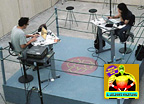
Net-Art Wrestling
Next week, two web artists will face-off in the wrestling ring to hack a web page live. The resulting changes will be seen by the public on a screen and by web-surfers on the net. The match is the latest in a series of net-art wrestling matches staged by Mexican artist Arcangel Constantini.
Throw your support behind one of the Campeones and read about the upcoming match on open_digi. Read an interview with Arcangel from petitMort. And read up on the project on we make money not art.
Posted by jesse at 01:14 PM | Comments (0)
December 06, 2005
On The Road: A Kerouac Circus

Transform a Book into a Performance
On The Road: A Kerouac Circus is a mixed-media event based on Jack Kerouac's classic American road-trip novel, using a set of procedures created by American composer John Cage to "transform a book into a performance."
Organized by Marc Thorman, the On The Road: A Kerouac Circus web site is part of a project to gather ambient sounds (sounds that happen to be in an environment) from locations mentioned in Kerouac's "On the Road" in order to create a sonic portrait of the big cities, small towns, backwoods, deserts and mountains that Kerouac visited and wrote about.
The project invites you to represent a location in the US, Mexico, or elsewhere by uploading a sound file for the mix of recordings that will be played during the performance.
You and/or your organization will be credited if you wish. (Hard copies -- CD's/flashcards -- can be sent by mail.) These sounds will be mixed with fragments of bop, folk, jazz and mambo recordings, vintage film clips, and live performances to create a "musicircus," the term Cage coined to describe an event in which many independent sounds and sights occur simultaneously and interact freely.
To participate, record ambient sounds (sounds that happen to be in the environment) at an urban or rural location listed on the locations page. These can be sounds of traffic, birdsong, wind, machines, footsteps, water, etc. This isn't a contest for "interesting" sounds -- ALL ambient sounds are welcome. You can choose to record at a specific site that is representative of the location, or choose a site by chance. Collect whatever sounds are there without knowing beforehand exactly what they will be.
Background
John Cage invented a new type of mixedmedia theatrical event, using chance combinations and multiplicity to reflect the way we experience the everyday world. In such a "musicircus" the elements--poetry, sound, dance, music--are created independently and then, like a three-ring circus, performed simultaneously. Cage's philosophy was that the chance combinations and multiplicities that arise from a musicircus are more interesting, and truer to our everyday life, than fixed relationships intentionally imposed by one individual.
In "_____ Circus On ____" Cage established a set of procedures to "transform" a book into a musicircus. The first "Circus On" was Cage's own "Roaratorio, An Irish Circus On Finnegans Wake." As Cage recited his poem taken from Joyce's novel, recorded ambient sounds from Ireland and around the world played through multiple speakers, Irish musicians played traditional instruments and sang, and dancers performed Merce Cunningham's choreography based on Irish dance. [Mode Records has recently re-issued the recording of "Roaratorio" with a comprehensive booklet containing an interview with Cage and a detailed explanation of each stage of the work.]
Applying Cage's procedures to "On The Road" creates a distinctly different musicircus, filled with sounds and images of cars, railroads, Americans towns and cities, be bop, old movies, mambo, cornfields, Sierra Madres, swamps, and prairie winds. The structure follows Kerouac and Cassady as they crisscross America from New York to San Francisco/L.A. and then drive through the South and into the roaring boulevards of Mexico City. The poem for the musicircus, composed entirely of word fragments from the book, reflects Kerouac's spontaneous prose rhythms and American speech patterns. Live performances, to be combined with the reading of the poem and the mix of sounds, come directly from the pages of the book--at various times during the performance (sometimes overlapping by chance) a DJ spins jazz tunes, dance couples swing and mambo, a bop trio blows, a folksinger sings "Halleluiah I'm a Bum" and clips from movie scenes are screened. Other live performances may include strolling guitarists singing Mexican songs, a nightclub singer, and an operatic tenor's a capella rendition of "Gott! Welch Dunkel hier!" from Fidelio.
Posted by jo at 02:44 PM | Comments (0)
November 29, 2005
Don Ritter Performances
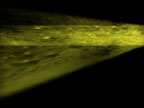
Digestion and Badlands
Don Ritter Performances in Budapest, December 4, 2005; Intro Festival Millinenáris Park, Budapest, Hungary.
Digestion:
Influenced by early 20th Century experimental animation, Digestion presents organic imagery--originating as boiling water--that is interactively transformed into a series of mechanical movements with synchronized sound emanating from the imagery. Using a pair of networked computers, viewers are presented with a hypnotic experience of multi-channel imagery that is controlled by sound. The seemingly unpredictable nature of the work provides an internal interactivity which can be observed by an audience, but not controlled.
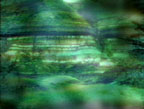
Badlands: Processed imagery of the Canadian Badlands are controlled and manipulated by live music. One or two networked computers use a musical analysis of live music to control clip selection, tempo and cinematic features of the video.
Since 1988, Don Ritter's interactive performances have been presented at festivals, museums, and galleries in North America and Europe, including the Art Institute if Chicago, New Music America (New York), Montreal Museum of Contemporary Art, and Steim (Amsterdam). [Related]
Posted by jo at 12:13 PM | Comments (0)
October 28, 2005
SPECFLIC 1.0

Sousveillance Grid + Community Built Display
The Community Built Display enables a group of people with wireless laptops to create a modular, flat-panel, dynamically reconfigurable large-format display. For SPECFLIC, The Outsider Jeremiad will serve as a ringleader of a group of audience members who want to send high-impact visual messages to those on the Inside. Developer: Robert Twomey, UCSD MFA Candidate, Visual Arts; Advisor: Natalie Jeremijenko, Visual Arts Dept., Xdesign Studio.
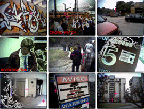
The Sousveillance Grid is a net-based interactive display which processes user-submitted camera phone images and displays them in a grid in a random fashion. Projected to the public SPECFLIC audience, it encourages bystanders to assist in documenting their surroundings with the efficiency and depth that only a populace armed with many, many cameraphones can provide. The display was created with PHP and JavaScript and can be viewed on any web browser. A proliferation of digital recording devices are leading us to a place where privacy will evaporate without any parallel efforts from the State — a community armed with compact, wirelessly-connected recording devices will record and police itself far better than any government could have hoped to. Developer: Andrew Collins, UCSD alum, ICAM’05, Calit2 Undergrad Fellow; Advisor: Adriene Jenik [Related 1, 2]
Posted by jo at 10:01 AM | Comments (0)
October 18, 2005
Three Crosses of Queensbridge
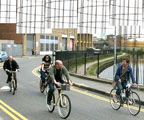
Acoustic Conversions
London-based artist Kaffe Matthews' Three Crosses of Queensbridge is a symphony for radios and bicycles. Replacing notes written on a musical staff are drawings on a neighbourhood map: providing various itineraries for visitors to follow on bikes, the artist broadcasts an electronic composition over a live radio signal. Cycling around the streets with radios receiving the broadcast, participants become performers and passers-by become accidental audience members.
The work is part of the Sounds like Drawing exhibition, at the Drawing Room, East London, 13 October - 20 November 2005. [via Regine on we-make-money-not]
Posted by jo at 06:18 PM | Comments (0)
DIAL-A-DIVA
![]()
Call For SINGERS and CONCERT GOERS
:: scroll down for info in French / German / Spanish / Portuguese::
Take Part in DIAL-A-DIVA an event spanning the globe for 24 hours,connecting singers and listeners live by telephone. The project is inspired by a period in history when the telephone was the first broadcasting medium for entertainment. From the 1880s to 1920s phone companies in many countries including France, Britain, Hungary and America set up subscription services connecting opera houses and theatres to a remote audience, listening via the telephone network. Dial-a-diva serves a similar function, but reflects today’s global telecommunications and social networks.
The event will start at 08:00 GMT on December 3rd in time for evening concerts in New Zealand and Australia. Then as time moves on, concerts will begin throughout Asia, the Middle East, Africa, Europe and ending with the Americas, 24 hours later. An installation at CCA Gallery, Glasgow, Scotland invites visitors to participate and view the hub of operations throughout the project.
To be part of Dial-a-Diva all you need to do is sing into a telephone, or use your phone as a microphone wherever singing happens. The Dial-a-Diva call centre will link as many different types of singing, from as many locations as possible to a wide international audience of telephone listeners. Whether at home, in a concert hall or bar, whether professionally or just for fun, whether accompanied or solo, whatever the singing Dial-a-Diva would love to have you taking part. Sign up, we call you back at the time of your concert wherever you are - world wide participation is free.
SIGN UP
online: www.dialadiva.net
email: dialadiva[at]gmail.com
phone: +44 (0) 141 227 1830 (UK landline)
This project is supported by a Creative Scotland Award and technically realised by Coveline, Intercall Europe, Commercial Decisions, Rook Technologies Inc. & CCA Gallery, Glasgow, Scotland.
----------------(Castellano)---------------
DIAL-A-DIVA :: Participar :: ¿Eres cantante o asistente a conciertos?
Dial-a-Diva es un evento que se extiende por todo el mundo durante 24 horas, conectando cantantes y oyentes por teléfono en directo. El proyecto de Zoe Irvine está inspirado en el periodo de la historia en el que el teléfono era el primer medio de radiodifusión para espectáculos. Desde la década de 1880 hasta la de 1920 las compañías telefónicas de muchos países, incluidos Francia, Gran Bretaña, Hungría y América, ofrecían servicios de abonado conectando teatros de ópera con una audiencia distante, que escuchaba el concierto por conexión telefónica. Dial-a-diva hace esta misma función, pero refleja las redes sociales y de telecomunicaciones globales de nuestros días.
El evento empezará a las 08:00 GMT del 3 de diciembre, a tiempo para los conciertos de la tarde en Nueva Zelanda y Australia. Después empezarán los conciertos en Asia, Oriente Medio, África y Europa, para acabar en América 24 horas más tarde.
Una instalación en Galeria CCA, Glasgow, Escocia, invita al espectador a participar y ver el centro de operaciones del proyecto.
Participar - Para ser parte de Dial-a-Diva lo único que tienes que hacer es cantar por teléfono o usar el teléfono como micrófono allá donde vayas a cantar. La línea de atención telefónica de Dial-a-Diva conectará todo tipo de cantantes, desde todas las localizaciones posibles, a un amplio público internacional de oyentes telefónicos. Ya sea en casa, en una sala de conciertos o en un bar, ya seas profesional o simplemente por divertirte, estés acompañado o sólo, ya sea una canción u otra, Dial-a-Diva está deseando que participes. Inscríbete, te llamaremos a la hora del concierto donde estés – está abierto a todo el mundo.
Inscripciones:
online: www.dialadiva.net
email: dialadiva[at]gmail.com
teléfono: +44 (0) 141 227 1830
Este proyecto esta subvencionado por Creative Scotland Award y cuenta con realización técnica de Coveline, Intercall Europe, Commercial Decisions, Rook Technologies Inc. & CCA Gallery, Glasgow, Escocia.
----------------(Deutsch)---------------
DIAL-A-DIVA :: TEILNEHMEN :: Sind Sie Sänger/in oder
Konzertbesucher/in?
Dial-a-Diva ist ein weltumspannendes Event, dass Sänger/innen und Zuhörer/innen für 24 Stunden live über Telefon verbindet. Das Projekt ist inspiriert von der historischen Periode in der das Telefon als erstes Übertragungsmedium für Unterhaltung verwendet wurde. Telefongesellschaften aus vielen Ländern, unter anderem aus Frankreich, Grossbritannien, Ungarn und Amerika haben zwischen 1880 und den 20iger Jahren des 19.Jahrhunderts ein Abonnementservice eingeführt, dass einer abgeschiedenen Zuhörerschaft ermöglichte, Aufführungen aus verschiedenen Opernhäuser und Theater live via Telefon zuzuhören. Dial-a-Diva hat eine ähnliche Funktion und reflektiert dabei die heutigen globalen telekommunikations und sozialen Netzwerke.
Das Event beginnt am 3.Dezember 2005 um 08:00h GMT – zeitgerecht für Abendkonzerte in Neuseeland und Australien. Den Zeitzonen veresetzt entsprechend, beginnen die Konzerte in Asien, im mittleren Osten, Afrika, Europa und enden 24 Stunden späeter in den Amerikas. Eine Installation in der CCA Gallerie Glasgow, Schottland, ladet Besucher zum Mitmachen und zum Beobachten der gesamten Operation ein.
TEILNEHMEN
Sind Sie Sänger/in oder Konzertbesucher/in?. Um dabei sein zu können benötigen Sie nur ein Telefon in das Sie selbst Singen oder einen Ort wo gesungen wird und Ihr Telefon dabei als Mikrofon benutzen. Dial-a-Diva verbindet möglichst viele unterschiedlichste Gesangsrichtungen von möglichst vielen unterschiedlichen Orten mit einer breiten internationalen Telefonzuhörerschaft. Ob zu Hause, in einer Konzerthalle oder in einer Bar, professionell oder zum Spass, ob eine Stimme oder viele, was auch immer der Gesang ist, Dial-a-Diva würde sich sehr über Ihre Teilnahme freuen.
Melden Sie sich online, via email oder Telefon an und Sie werden von uns zum Zeitpunkt des Konzerts kostenlos zurückgerufen – wo auch immer Sie sich befinden.
Anmeldung durch:
online: www.dialadiva.net
email: dialadiva[at]gmail.com
telefon: +44 (0) 141 227 1830 (UK landline)
Dieses Projekt ist von Creative Scotland Award gefördert und technisch umgesetzt von Coveline, Intercall Europe, Commercial Descisions, Rook Technologies Inc. & der CCA Gallerie Glasgow, Schottland.
----------------(Francais)---------------
DIAL-A-DIVA :: Vous estes un chanteur ? Un spectateur ? :: PARTICIPER
Dial-a-Diva est une action artistique qui traverse le globe pendant 24 heures, soit l'interconnexion de chanteurs et d'auditeurs en direct au téléphone. Ce projet se réfère à une période de l'histoire où le telephone était considéré comme un médium de diffusion de programme de musiques et d'entertainment. Des années 1880 à 1920, les compagnies de téléphones de nombreux pays comme la France, la Hongrie, le Royaume-Uni et les États-Unis, mirent au point un service de souscription qui proposait des écoutes en directs des Opéras et Théâtres à une audience connectée au réseau téléphonique. Dial-a-Diva rempli aujourd'hui une fonction identique, tout en reflétant l'esthétique et la philosophie des réseaux aujourd'hui.
L'action commence à 08:00 GMT le 3 décembre 2005, en synchronisation avec le débuts de concert lyriques en Australie et en Nouvelle Zélande. Puis d'un décalage horaire à l'autre, les concerts surgiront d'Asie, du Moyen Orient, d'Afrique, d'Europe et s'achèveront en Amérique 24 heures plus tard. Une installation au CCA de Glasgow en Écosse, invite les spectateurs-auditeurs à participer et à suivre le théâtre des opérations.
Pour participer à Dial-a-Diva tout ce qu'il vous suffit de faire c'est de chanter dans votre téléphone, ou utiliser votre téléphone portable comme microphone partout ou il y a de la chanson. Le centre d'appel Dial-a-Diva va diffuser toute sorte de chants, de partout dans le monde à un public international d'auditeurs téléphoniques. Si vous êtes chez vous, ou dans un bar ou une salle de concert, si vous êtes amateur ou professionel, de n'importe quel style de chanson, Dial-a-Diva sera heureux de votre participation. Inscrivez -vous, on vous appellera à l'heure de votre concert quelque soit l'endroit ou vous êtes. La participation est gratuite.
Inscrivez -vous
online: www.dialadiva.net
email: dialadiva[at]gmail.com
tel: +44 (0) 141 227 1830 (téléphone fix GB)
Ce projet est soutenu par une bourse de Creative Scotland.
Réalisation technique: Coveline, Intercall Europe, Commercial Decisions, Rook Technologies Inc. & galerie CCA, Glasgow, Ecosse.
----------------(Portugues)---------------
DIAL-A-DIVA (Disque-Diva) :: PARTICIPE :: Você é cantor/a ou freqüentador/a de concertos?
DIAL-A-DIVA é um evento abarcando o planeta durante 24 horas, conectando cantores/as e ouvintes ao vivo por telefone. A inspiração do projeto da artista escocesa Zoe Irvine foi um período na história quando o telefone foi o primeiro meio de transmissão usado para entretenimento. Da década de 1880 até a década de 1920 empresas telefônicas em muitos paises, entre os quais a França, o Reino Unido, a Hungria e os EUA., estabeleceram services por assinatura, conectando assim casas de ópera e teatros a um público remoto que ouvia pela rede telefônica. Disque-Diva preenche uma função semelhante, porém reflete as redes globais atuais, tanto sociais como as de telecomunicações.
O evento começará às 8 horas GMT no dia 3 de dezembro em tempo para pegar os concertos noturnos na Nova Zelândia e Austrália. Conforme a hora vai avançando, outros concertos começarão na Ásia, no Oriente Médio e na África, terminando 24 horas mais tarde nas Américas. Uma instalação no CCA (Centro para Artes Contemporâneas) em Glasgow, na Escócia convida visitantes a participarem e observar o centro de operações durante todo o projeto.
PARTICIPE - Você é cantor/a ou freqüentador/a de concertos ? Para participar no Disque-Diva a única coisa que você precisa fazer é cantar no telefone ou usar o seu telefone como microfone em qualquer lugar onde estiver alguém cantando. O centro de ligações de Disque-Diva vai
Conectar tantos quantos estilos diferentes de cantar e tantas quantas localidades possíveis a um grande público internacional de ouvintes por telefone. Seja em casa, numa sala de concertos ou num bar, seja profissionalmente ou somente por diversão, acompanhado ou solo, seja que for o cantar, Disque-Diva adoraria ter a sua participação. Assine já - nós ligaremos para você na hora do seu concerto onde você estiver – a participação em qualquer lugar do mundo é grátis.
online: www.dialadiva.net
email: dialadiva[at]gmail.com
Telefone: +44(0) 141 227 1830 (telefone fixo – Reino Unido)
Este projeto foi possível graças ao prêmio “Creative Scotland Award”, com realização técnica por Coveline, Intercall Europe, Commercial Decisions & Rook Technologies Inc. & CCA (Centro para Artes Contemporâneas) Glasgow, Escócia.
_______________________________________________
a m b i t : networking media arts in scotland
post: ambit[at]a-r-c.org.uk
archive: www.a-r-c.org.uk/ambit
Posted by jo at 04:53 PM | Comments (0)
October 11, 2005
Graveyard Games
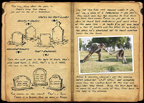
Playing Tombstone Hold 'Em
On Saturday October 15, 2005, Graveyard Games will be in Colma, San Francisco’s very own City of the Dead, so you can meet the living and play with the dead. You’re invited to the Italian Cemetery to get to know your local dearly departed, pay your respects, and learn Tombstone Hold ‘Em—the secret poker game you can only play in a cemetery.
Instructions: 1. Arrive at the Italian Cemetery (540 F Street, Colma, CA 94014, 2 blocks from Colma BART station) on Saturday October 15 between 1:30 PM and 2:00 PM. 2. Look for your host near the main entrance, under the white arch. She’ll be holding a deck of cards. She will have further instructions and supplies for you. 3. Bring a single flower to place on a grave to show some respect, and to signal that you’re one of us.
4. Take a few minutes to explore the cemetery. Look for any poker chips left on tombs. You’ll need these to play.
5. Be sure to look for the grave of someone you can prove died on your birthday. You can use that tombstone as a Joker during the game.
6. Tombstone Hold ‘Em Tournament begins at 2 PM. Here’s a tip: learn the rules before you come. We’ll have instructions on hand for any friends you bring along.
7. For non-poker players, there will be other creative, playful things to do. And expect a few surprises.
8. The winner is crowned at 3 PM. No fancy prizes, but lots of respect, and maybe a special memento from beyond the grave. Plus, everyone can keep the chips they earn as a souvenir.
9. After 3 PM, you’re invited to nearby Globe Tavern (7379 Mission St) to raise a glass to the players you’re leaving underground at the Italian Cemetery.
By the way, if anyone asks--you’re here for the last call. [posted by Jane on Avant Game]
Posted by jo at 09:19 AM | Comments (0)
October 10, 2005
Found Sound in D.C.
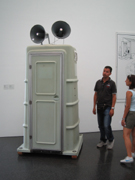
Crisscross a City
[Unrelated photo: a port-a-potty-based public address system at the MACBA, Barcelona, 2005.]
A public art project called FOUND SOUND will be featuring works from artists in sound booths (“reconfigured” Port-a-Potties) on sidewalks in public locations throughout Washington, D.C. from Oct 14-Nov 5. Participating artists include Richard Chartier, Joseph Grigely, Alberto Gaitán, Jennie C. Jones, Helmut Kopetzky, Brandon Morse, Robin Rose, and Alex Van Oss. Actor and part-time New Orleans resident Harry Shearer (The Simpsons, Spinal Tap, HuffPo) is contributing a piece on Hurricane Katrina, and Calvin Trillin has contributed a poem as well. The press release quotes this from an essay by Nora Halpern at Americans for the Arts:
FOUND SOUND entices the listener to crisscross a city to experience fully this collection of work. As one leaves a destination for another—whether by foot, car, bus, or Metro—the heightened audio awareness encouraged by each piece should continue, like a musical riff, through all the spaces in between.
That’s great and all, but in most of the places where these will be, “heightened audio awareness” might not be a good thing. Downtown D.C.’s not known for its street life — but we have plenty of nice, loud traffic and construction. Maybe they should make a podcast available for walking in between. Local galleries including Fusebox, Conner Contemporary Art, the Goethe Institute, and DCAC are collaborating. No map seems to be available yet but we’ll link when it turns up online. No word on whether any of the port-a-potties will be performing their originally intended public service as well, but consider it highly unlikely. [blogged by Tim on shey.net]
Posted by jo at 06:36 PM | Comments (0)
September 27, 2005
Physical Metadata
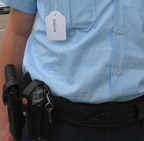
tag, tagged, taggers, tagees
"Classifying objects is no longer a responsibility for a torturous team of meticulous librarians. On the internet, users freely classify each others websites, images and texts by adding tags, which other users can browse and use to find things.
Users can tag URLs (on del.icio.us), photographs (on flickr.com) soundsamples (freesound project) and undoubtedly a myriad of other online objects. Online this creates a open structure of information about information otherwise known as metadata, but what happens offline? How can things in the real world be democratically defined?
The Physical Metadata project attempted introducing tagging into the real world. 55 words were printed on cards (tags, really) and could be attached to real objects in the physical world. More examples of what happened can be seen on http://www.flickr.com/photos/tags/physicalmetadata." [by Nadya Peek, Mediamatic]
Posted by jo at 12:23 PM | Comments (0)
September 20, 2005
Remain in Light

Netting Ambient Analog Sound Waves
[...] Remain in Light, by Haruki Nishijima, is a visual representation of ambient analog sound waves captured using an "electronic insect-collecting kit." The "collector" carries an insect net that functions as an antenna and is attached to a device designed to capture the waves. Participants walk outside with the net. Through headphones, they can listen to phone conversations, AM radio, taxi drivers’ and police radio communications. A button on the handle allows collectors to record one-second sound bites.
These fragments of analogue information are transmitted to a computer that transforms them into points of light that are then projected onto the exhibition space. Each frequency is represented by a different colour. When visitors enter the space, their presence and movements are detected by sensors. This is how the "electronic insects" are activated, disperse then progressively disappear. Each light source is accompanied by a sound. The installation can be activated on the Internet. Remain in Light was part of the Touch Me festival in Zagreb, Croatia [...] Related: Tools for radio wave hunters [blogged by Regine on we-make-money-not]
Posted by jo at 11:50 AM | Comments (0)
September 19, 2005
The Hunt for Mr. X:
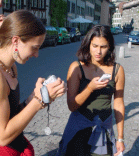
Bringing a Board Game to the Street
"Scotland Yard" is a popular board game in Europe, where players have to catch Mr. X. Mr. X moves hidden through the streets of London. He has to show his location every 4th turn. The detectives know which kind of transportation he uses. With this information they have to figure out his position and surround him. When the detectives catch him, they win, if Mr. X escapes he wins.
Bringing the game to the street: transformation into a live action game 4 groups with 4 players hunt Mr. X and Mr. Y in the old city of Berne. Hunting by MMS: Every ten minutes, Mr. X sends a picture of his current location. The detectives have to identify the position by the pictures and find Mr. X. They catch Mr. X by taking a picture of him." From "The Hunt for Mr. X: Bringing a Board Game to the Street [PPT] by Niklaus Moor (Swisscom Innovations). [via techkwondo] [Related]
Posted by jo at 11:51 AM | Comments (0)
September 18, 2005
Glowlab News
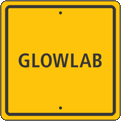
GLOWLAB.04 :: FORGOTTEN and more
GLOWLAB.04 :: FORGOTTEN--Our latest issue is now online, and features some great new projects by Glowlab and guest artists, including:
:: kanarinka--12 Inches of Weather; Weather experiments on the body :: Sharilyn Neidhardt --Into the Groove; Interview with musician and audio archivist Steve Espinola :: Emily Conrad--Lost Phone: 18,900 Google Entries; Lost phone in the back of New York City taxi. Last Friday, around 1am. It must happen all the time :: Sal Randolph--whereyouare; Join in documenting the endangered, lost, or ephemeral beauties of your neighborhood. whereyouare is a participatory experiment, mixing collaborative multimedia, folksonomy tags, and rss feeds to build a portrait of places that matter to us :: Holly Tavel--Xanadu Revisited; Two years on, Xanadu gives up the ghost.
With special guests: Leah Dilworth :: Lost and Found at the City Reliquary; Tour the City Reliquary, Brooklyn's store-front museum dedicated to civic pride and all around good neighborliness; Tianna Kennedy :: On Forgotten, Neglected, and Discarded Objects and Subsequent Utopian Projects Or, the Meandering Story of EV, which recounts the amusing first sally of the ingenious crew as they dragged a thing that had been forgotten from the Bronx to the Lavender Lake; Michele Gambetta :: The Rider Project 2005; The RIDER Project has been created by artists who rent a Ryder Company truck, retrofit it with walls, gallery lights, a generator for electricity, and create a mobile gallery to display art throughout N.Y.C.; Petr Kazil :: Urban Spooklights; Who wouldn't get excited by the appearance of a mysterious light in the distance - in a place where no light is expected?
Glowlab: Open Lab, curated by Christina Ray: A nine-week-long psychogeography festival and exhibition; October 14 through December 11.
Please join us this fall as we head up to Boston for our show at Art Interactive, a non-profit arts space dedicated to contemporary, experimental and participatory artwork.
In Fall 2005, Art Interactive is conducting a nine-week-long experiment. We have invited artists affiliated with Glowlab, a network of psychogeographers, to use the Central Square neighborhood as the site of their research and fill the exhibition space with the results of their investigations. PSYCHOGEOGRAPHY, a term coined by the Situationist International in the 1950s and appropriated by contemporary artists, is used to describe projects that produce affect in relation to the geographic environment. Rather than making maps in the traditional geographic sense, these artists utilize maps and geography to conduct located experiments with (among other things) people, trash, bikes, clothes, the sky and the gallery space itself. Often making use of mobile technologies and existing in the hybrid spaces of the Internet and the physical world, their projects produce new understandings of location and identity as shifting, fluid, singular and irreducible.
Central Square, Cambridge, MA, will never be the same again. Join us for nine weeks of public walks, talks, tours, workshops, concerts, group bike rides, and other ways of exploring the Central Square neighborhood. Each weekend of the festival, different Glowlab artists will be present to lead participatory public events inside and outside the Art Interactive space. Visit the online schedule at http://www.artinteractive.org/calendar for more details about upcoming events or email info[at]artinteractive.org.
Opening Reception: Friday, October 14th, 2005, 6 - 9pm
Gallery Hours & Location: Art Interactive is open Saturdays and Sundays from 12 - 6pm or by appointment. The gallery is located at 130 Bishop Allen Drive, at the corner of Prospect Street in Cambridge, MA. For more information, please contact info@artinteractive.org, call 617-498-0100 or fax 617-498-0019. Press release with downloadable press kit:
http://www.artinteractive.org/shows/glowlab/glowlab_press.html
Posted by jo at 10:21 AM | Comments (0)
September 16, 2005
The Knitting Map

Knitted Cartography
The Knitting Map is a fabric art and technology project that aims to take the pulse of the city of Cork (Ireland) during 2005 and translate that information into a live knitting map. Above the earth there is a satellite which looks down at Cork (Ireland) and watches the movements of people and cars around the city. Down in the hub, small cameras watch the city in detail and meteorological equipment tastes the weather. All of the data coming needs to be distilled into two simple numbers: one representing stitch (pattern) and the other colour.
There are 25 knitters, so information must be varied slightly between each knitter to give the overall textile a more subtle and complex hue. Knitters work in relay, the strips sewn together to form a single vast document of the city. Before each of them, a small digital screen details the next few lines of knitting and they lean forward to advance the pattern. During the day, people arrive to view the installation. By performance company half/angel. Pictures. Part of Cork 1005, Capital of Culture. [blogged by Regine on we-make-money-not]
Posted by jo at 10:30 AM | Comments (0)
Grand Finale_Yellow Arrow:
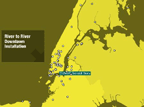
The Secret New York
Yellow Arrow: The Secret New York is a public art project that celebrates the extraordinary details of the city that often pass unnoticed. Upon encountering a Yellow Arrow, the public participates by calling 212.201.2005 from mobile phones to hear an audio message that tells a secret story about the location where the arrow points.
This Saturday marks the Grand Finale with 20 Yellow Arrow sculptures visible across Manhattan and Brooklyn from 12-8 pm, at places like: Union Square, Chinatown, The Lower East Side, East Village, Lower Manhattan, Williamsburg and DUMBO. This is is a fantastic opportunity for people to experience some of the most compelling content of the summer in one single day.
Over the summer the project has touched a lot of people in all 5 boroughs and there are some very fun stories about bringing it all together. Creators of the project will be leading two behind-the-scenes tours to share these anecdotes and insights. Tour 1_Lower Manhattan meets at Battery Park at 12 pm and will visit 5 nearby Yellow Arrows. Tour 2_East Village meets at corner of Ave. B and E. 7th St. at 6:00 pm and will visit 6 Yellow Arrows, grab dinner in the area and head to the after-party.
The day-long installation and tours will be followed by a celebration at the Lotus Lounge (35 Clinton St at Stanton), with drink specials, video projection and a sound installation on the street.
Grand Finale, Downtown Manhattan, Williamsburg and DUMBO; 12-8 pm; Full map available.
Tours:
Tour 1_Lower Manhattan 12 pm at Battery Park
Tour 2_East Village 6 pm at corner of Ave. B and E. 7th St
Grand Finale Party--Lotus Lounge, 35 Clinton Street at Stanton, Lower East Side, Manhattan.
Posted by jo at 10:22 AM | Comments (0)
August 23, 2005
GilbertandGrape
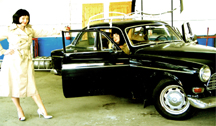
By the Way
In their performance By the Way GilbertandGrape park their Volvo Amazon alongside café’s, galleries and car parks, put up a fake sunset and place a stuffed moose in front. They invite people into the car to choose a nostalgic song to listen too whilst watching the fake sun set. They make a fictional frame from a cliche and within this generate texts and exchange information together with the audience. GilbertandGrape re-present the cliché elg I solnedgang (moose in sunset) and ask what kind of relation do we have to it in contemporary rhetoric?
26 August: Talk Blog as public space. Introduction to performance By the Way; Kl 19:00 Atelier Nord, Oslo, Lakkegate 55 D. www.anart.no
27 August: Performance By the way in collaboration with Atelier Nord. KL 20:00-22:00. Kuba Pavilion, Fyrhuset ved Maridalsveien 19.Oslo
29 August: Talk Networks for performance artists/Introduction to Taoh residency in Stavanger. Video Lone Ranging Romance. UKS Oslo, Kl 19:00 Lakkegata 55 C.
02-03 September: Performance By the way at Kunstbanken Hamar, performance weekend, Hedmark, Kl 14:00-16:00, KUNSTBANKEN - Hedmark Kunst senter - Parkgt. 21, Hamar.
Posted by jo at 09:28 AM | Comments (0)
July 28, 2005
Human Scale Chess Game
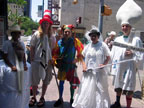
We Call Your Moves
Join the eighth Human Scale Chess Game in Oakland on Saturday, August 06. The organizers need 32 volunteers with working cellphones to play the roles of the chess pieces. Sign up now by email to select the role you will play. To participate, you will need a working cellphone and a couple of free hours on Saturday August 06. Costuming is strongly encouraged; the campier, the better.
SMS simulcasting and webcasting will likely be used during the Oakland game and there will be an afterparty. Check the site for updates as more details become available. Human Scale Chess is a project of Glowlab contributor Sharilyn Neidhardt. [via Glowlab]
Posted by jo at 04:44 PM | Comments (0)
July 27, 2005
Cracks in the Pavement:
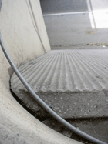
Gifts in the Urban Landscape
Cracks in the Pavement: Gifts in the Urban Landscape is a multi-phased, interactive project that calls attention to the “in-between” spaces encountered throughout everyday life. The project focuses on details within the urban landscape and encourages close inspection of our social space. This summer, artists based in locations around the world will respond to what they find in their urban environments by making art objects designed to be placed in sites that intrigue them—at bus shelters, in alleys, under bridges, in libraries or post offices, or deep in park bushes. Members of the public are invited to search for these site-specific works using maps and clues provided at the web site. Art works featured in Cracks in the Pavement may be kept by whoever finds them. Works not found will be allowed to remain in the landscape indefinitely to be encountered by chance, displaced, or transformed by the very environmental forces that define each piece's context.
The process of discovery lies at the heart of the project. It invites people to engage with their surroundings intimately, encouraging any number of potential encounters or experiences provided in the act of searching. Every environmental detail reveals evidence for an event occurring at a moment in time, as careless and forgettable as roadside trash thrown from a car window or as sublime as the cracks in a building’s foundation caused by an earthquake or tornado. Cracks in the Pavement asks us to ponder where we are in relation to what surrounds us. It calls attention to what we pass by every day, as well as what we leave behind.
Cracks in the Pavement was started in Austin, Texas, in June 2004. The project featured site-specific works by 15 Austin-based and international artists both in Austin and in London, UK and was presented as part of the London Biennale 2004. This year, the project will be launched in multiple phases in different locations throughout summer 2005; click here for a list of participating artists, locations and launch dates. Cracks in the Pavement is organized by Heather Johnson, and will be on view throughout the summer until the last piece is found.
Posted by jo at 07:58 AM | Comments (0)
May 30, 2005
real-time autobahn
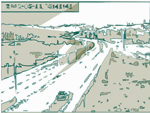
the freeways of art practice
Pall Thayer's latest work Autodrawn, subtitled: Sketching landscapes seen through my window, is a real-time software application that renders or "sketches" an image grabbed from online freeway webcams. In reference to the Krawftwerk song Autobahn, Pall presents a contemplative, aesthetically based experience of the increasingly complex associations with freeway culture.
The experience is meditative in its abstraction and repetition: the image is never completed before it is wiped and redrawn. The experience is made richer with the accompaniment of the sound assemblage made of electronica and what seems to be police and traffic control audio pulled from scanners.
There are no bodies or human interaction in this work, but the proposition that the computer is performing as an intermediary of a live moment. Autodrawn personifies the computer through a first person perspective. The pronoun in the subtitle is the computer's. Pall presents the computer as playing artist by co-opting the artists creative exercise of sketching, real-time drawing as consciousness, and the appropriation of public web cam images as framing the computer's subjectivity: my windows: my eyes.
Pall describes the work: "The rapid pencil sketch is one of the staples of traditional visual arts. It can be anything from simple art-calisthenics and studies to a full blown work of art. Here we see the computer "playing" artist, making rapid sketches (traces) of landscapes (real-time images from traffic cameras) seen through its windows (browser windows). The subject matter is something that many of us take for granted, seldom stopping to consider the aesthetic charm of the increasingly complex structures that Kraftwerk sang so memorably about in their song "Autobahn". But they portrayed the freeway as a blissfull place for a leisurely, automotive, family outing. Can this place of increasingly severe accidents, con-artists, high-speed police chases and practice-range for morally deprived gun owners still be seen in the serene imagery conjured up by Kraftwerks song?
Now, instead of being presented with the profoundly "pretty" cover-art by Emil Schult, we are presented with "the real thing" in real-time, drawn by a machine that takes a completely abstract approach to the subject matter. The accompanying music, instead of an underlying melody tricked out with spacy synthesizer effects, flutes and guitars, is garnered with live streams of police scanners, those pillars of public safety that now scour the majestic cement structures that are at the same time a constant threat to human life and an essential element in modern city living."
Pall also makes the source code available to others.
Posted by michelle at 03:06 PM | Comments (0)
ResonanCITY
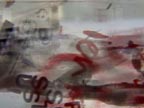
Live Audiovisual Performance
Many sounds and images in our everyday lives slip past our notice simply because they are too small, or because we lack the proper receivers to pick them up. ResonanCITY is an ongoing project to gather these microscopic sounds from various cities, and to amplify and transform them. The goal is to build a new city of sound and visuals inside the old one, and to inspire curiosity and exploration of one's own environment. Video artist Sara Kolster, searches for details and objects which she transformed in a microscopic way into macro-images. She uses different macro-lenses and a lightbox, capturing and manipulating these images live, without the use of any filters. The combination of film- and video techniques with analogue tools as found footage, positive film and photographs gives the performance a layered character.
The sound of resonanCITY is based on gathering elements which are specific to each location and reinterpreting them in a performance setting. Field recordings, found objects, folk music and spoken texts are mixed and processed live with the computer with the intention of uncovering hidden details and nuances that escape everyday perception. For some performances, the audience is encouraged to bring objects which they think might become interesting if listened to more carefully, and an improvisation is based on these objects. Quicktime movie.
Posted by jo at 12:29 PM | Comments (0)
April 20, 2005
InterPlay: Loose Minds in a Box
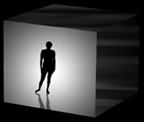
Six by Six
InterPlay: Loose Minds in a Box is a collaborative work that explores the basic concept of the "box". The box is a metaphor for the physical, social, political or psychological constraints that we and/or others place upon us. The box also represents a sense of place in the realm of the virtual as well as in our sub-conscience. InterPlay is a multi-faceted telematic event that consists of six simultaneous performances that occur in six states throughout North America. The performances incorporate theater, text, music, performance art, virtual reality, and motion capture and are concurrently captured, mixed, digitized, encoded and streamed onto the network.
Posted by jo at 08:42 AM | Comments (0)
February 11, 2005
GilbertandGrape
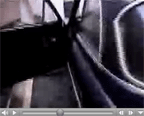
First Chapter: Lone Ranging Romance
10/02/05 13.00: Latitude 550 North, Body temperature: 36.8 c. Weather: Rain shifting to hail. First Chapter: we were about to take the Volvo Amazon for a spin and map out an interview. It seems like the ignition might need to be replaced before we do, alas another day at the garage for GilbertandGrape. So put on your favourite music and watch the sun set, knowing that we do that to. See you next month same channel same day. We are currently reading poetics of failure. Check out this networked performance on the link Live Reportage
Every Thursday in the second week of the month GilbertandGrape will be sending a live reportage of their preparations and work with Lone Ranging Romance. By interviewing heroes we meet on our drive/way we look to document a fragrance of nostalgia. Our quest is to return the lone ranger(elg) to the sun never setting. Lone ranging romance - our epic storyline for the next 4 years. Watch our live reportage online. Stay tuned and meet us for a date.
Posted by jo at 02:25 PM | Comments (0)
December 27, 2004
netzwissenschaft
![]()
Emerging Infrastructures of All (Inter)net Research
Dr. Reinhold Grether's network research | netzwissenschaft site maps the "emerging infrastructures of all (inter)net research endeavours. net.science as an anthropology of connectivity is trying to overcome the constraints of specialist method transfers on net matters. the protuberance of technical networks necessitates a professionalization of human net knowledge. neither the isolation of concepts as in basic research nor the encapsulation of processes as in applied sciences will ever be able to adequately describe the complex autopoiesis of networks. net.science is undoubtedly developing into a scienza nuova of its own right."
Check out his Mobile Art and Virtual Performance research areas.
Posted by jo at 04:45 PM | Comments (0)
December 20, 2004
S.S.S
![nancy4b[1].gif](http://www.turbulence.org/blog/images/nancy4b[1].gif)
Laptop and body performance
S.S.S is a trio -- Cécile Babiole, Laurent Dailleau, and Atau Tanaka -- performing visual music with sensors and gestures. They create a work of sound and sight, a laptop performance enriched by the intensity of bodies in movement.
Sensors capture gesture and corporeal movement, translating them into digital data:
- Ultrasound sensors measure the distance between the performer’s hands and her machine, allowing her to articulate 3D imagery, navigating in color, scale, texture…
- The Theremin, an oscillator invented in 1919, responds to perturbations of electrostatic fields based on the distance of the hands and body to the instrument.
- The BioMuse places gel electrodes on the performer’s forearms, analyzing EMG biosignals. Muscle tension through concentrated movement allows the musician to sculpt sound synthesis. (Posted by Régine Debatty)
Posted by Regine at 01:00 AM | Comments (0)
December 14, 2004
Where on-line meets on the streets:
experiences with mobile mixed reality games
"We describe two games in which online participants collaborated with mobile participants on the city streets. In the first, the players were online and professional performers were on the streets. The second reversed this relationship. Analysis of these experiences yields new insights into the nature of context. We show how context is more socially than technically constructed. We show how players exploited (and resolved conflicts between) multiple indications of context including GPS, GPS error, audio talk, ambient audio, timing, local knowledge and trust. We recommend not overly relying on GPS, extensively using audio, and extending interfaces to represent GPS error." From M.Flintham, R.Anastasi, S.Benford, T.Hummings, A.Crabtree, C.Greenhalgh, T.Rodden, N.Tandavanith, M.Adams, and J.Row-Farr (2003). Where on-line meets on the streets: experiences with mobile mixed reality games. In Proceedings of the conference on Human factors in computing systems, pages 569–576, Florida, USA. [via pasta and vinegar]
Posted by jo at 02:53 PM | Comments (0)
December 03, 2004
Bridging Series

performance intervention
Sifting the Inner Belt would like to invite you to the first performance intervention as part of their "Bridging Series."
DATE: Friday, December 3rd
TIME: 6 to 8 PM
LOCATION: The Boston Center for the Arts‚ Mills Gallery
The "Bridging Series" takes place in the South End neighborhood creating direct and indirect "bridges" between the Boston Center for the Arts and the Berkeley Street Community Garden, both of which are long-standing neighborhood institutions. The series coincides with select South End "First Friday" gallery openings. The performances take the form of "instruction works" requiring audience participation.
Directions/instructions for the performances will be available at the plaza in front of the BCA Mills Gallery, while the performances may take place in various locations throughout the South End. These performance interventions will take place, rain or shine (or snow).
Sifting the Inner Belt is a year-long social performance and research art project that consists of a series of performance interventions and performance-based research projects, which closely observe and examine, i.e. sift, the South End neighborhood with an emphasis on creating emotional, conceptual and physical bridges between the Boston Center for the Arts (BCA) and the Berkeley Street Community Garden (BSCG). This project was developed as a collaboration of artists, activists and community residents: Jeremy Chu, Catherine D'lgnazio, William Ho, Hiroko Kikuchi, Jeremy Liu, Natalie Loveless, and Kim Szeto. An exhibition based on and documenting Sifting the Inner Belt is scheduled for the Mills Gallery from June 17 to July 31, 2005.
We hope you can join us!
For more information about the project, please visit our website at: http://communitygarden.typepad.com
For directions and information to the Boston Center for the Arts, please visit their website at: http://www.bcaonline.org
Posted by jo at 01:17 PM | Comments (0)
December 01, 2004
HERE

A Meta.Pervasive.Game
HERE, by Jason Wilson and the members of (N.I.N.E), is a pervasive game allowing 2-16 people to get to know better a city. Players get markers, chalk, sticky notes and 2 identical decks of 50 cards each.
Each team get their cards which come with a set of instructions to follow. The player who draws a BLANK CARD must invent the instruction for that round. The cards are all printed on sticker paper, and the players are encouraged to stick the action cards up in the locations as they're finished, that way, at some later date, a random pedestrian may end up being inspired toward detournement.
A new version of the game will be launched December 4th during the La Superette event and it will come with a copy of their own "community gaming map." By the look of the pictures, that game won't come too soon in my town.
From near near future
Posted by jo at 12:44 PM | Comments (0)
November 23, 2004
The Gambit
![]()
The Narrative Abilities of Flowers
The Gambit is a portable interactive animation sited in the lobby of the Westin-Bonaventure Hotel (John Portman, 1977). The medium of the project is a digital compass attached to a PDA ("personal digital assistant") with a two and a quarter inch by three and a quarter inch color screen and headphones. This apparatus worn by the viewer displays images of spaces normally inaccessible to the viewer's vision from within the Westin's lobby, in other words, as if you're seeing through walls with a kind of periscope.
The "seeing through the walls" has a shape, like Gordon Matta Clark's cuts through buildings. The shape is configured by animated still images and sound. The still images and sound tell a story. The story is of a hotel flower arranger, and of a parallel world where flower arrangements have archival and narrative abilities. The Gambit is a project of Kati Rubinyi.
Posted by jo at 09:45 AM | Comments (0)
November 20, 2004
Evidence Locker

Retrieval Room
For the Liverpool Art Biennal, American Jill Magid worked with the operators of the city's CCTV surveillance cameras to teach them the techniques of professional filmmakers.
During one month, Magid wore a red trench coat and boots, ensuring she could easily be spotted throughout the city. She called the police on duty with details of where she was and asked them to film her in particular poses and even guide her through the city with her eyes closed - all using the public surveillance cameras. All around Magid, the most innocent passers-by were transformed into potential bag-snatchers, rapists and serial killers by the camera's behaviour.
The final work was made into two installations: Evidence Locker at Tate evokes the space of the CCTV monitoring station, with a soundtrack of the police log being read aloud, and CCTV footage featuring the artist. Evidence Locker at FACT reveals Magid's evolving relationship with the CCTV staff through a daily diary and video projections [until November 28th at the FACT gallery in Liverpool.] From near near future.
Posted by jo at 10:22 AM | Comments (1)
COCKFIGHT ARENA
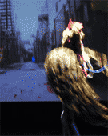
With Wings and Feathered Helmuts
Cockfight Arena (Eddo Stern with Mark Allen, Jessica Hutchins, Karen Lofgren): a one night parade of sweat and adrenaline hopes to reclaim performance art in the age of video games, pitting viewer against viewer in brutal virtual cockfighting theater. Audience volunteers suited up in custom-made wireless game controllers with full sized wings and feathered helmets. Combatants stepped into an arena to control their life size game avatars through vigorous flapping and pecking, competing for blood and birdfeed while rapaciously inflicting onscreen bodily harm in a custom made "joustlike" fighting game. [via]
Eddo Stern was born in Tel Aviv, Israel. His working interests are in structures of narrative and documentary, fantasies of history and technology, cross-cultural representation, and the phenomenological and cultural expanse of computer games. He works discriminately with a wide variety of media—computer games, electronic devices, software, video, sculpture and performance. His work has been shown internationally at new media and film festivals, museums, galleries, and game conventions. In 2000 he started «C-level,» a cooperative artist-run new media lab and art space in LA's Chinatown; currently lives near Los Angeles.
Source: http://www.medienkunstnetz.de/artist/stern/biography/, Florian Zeyfang, Interview with Eddo Stern, Tages Anzeiger, February 2002 and web at http://www.c-level.cc
Posted by jo at 09:53 AM | Comments (0)
November 11, 2004
Kiosk Correspondance
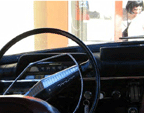
remote-live-networked-interactive-performance
Kiosk Correspondance November 14, 2004, 18:00 - 21:00: Get the facts of gilbertandgrape's whereabouts and mischief in Kiosk Correspondance at the East End Collaborations festival and online. Give us a cassette, a song of romantic significance to play in the Volvo; you can drop it off at the gilbertandgrape office installation at the EEC or email us a suggestion. Kiosk Correspondance is a remote performance with an online connection, and uses phone conversations and live documentation.
Between 2004 and 2008 GilbertandGrape and their lone ranger, a 20 kilo stuffed moose head, will travel the coasts of England and Norway in a Volvo Amazon to search out and collect stories from people with an interest in nostalgia, document vague memories, exchange taped music and watch sunsets at the end of the day.
East End Collaborations 2004
Saturday 13 and Sunday 14 November
an intensive weekend of new work by new artists
Queen Mary, University of London,
Mile End Road, London E1
Venue: The Arts Building, Queen Mary, University of London, Mile End Road, London E1 4NS. (between Mile End and Stepney Green Tubes).
The EEC Platform is an opportunity for emerging practitioners from across London to present new performance and time based works and an invitation to audiences to experience the artists of tomorrow today.
Tickets: £5 (£3 concessions) per day or £8 (£6 concessions) for a 2 day pass.
Bookings: 020 7882 5196
Concessionary tickets are available for wheelchair users and an accompanying person. Please indicate at time of booking any special requirements, wheelchair space or any other mobility assistance. The theatre and other performance and installation spaces do not have hearing induction loops.
Posted by jo at 08:38 PM | Comments (0)
Utopia Travel
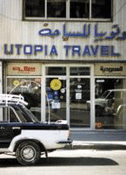
A Journey in Search of (post)modern Utopia
Utopia Travel is a collaborative project by Austrian Artists David Rych and Emanuel Danesch. The basis of the project is the transport of a video collection from Cairo to Vienna, following the transition from the upper part of the African continent over the Middle East towards Europe. An Egyptian taxi equipped with a video monitor served as a mobile unit distributing the contents of the video-archive on the distances between the capitol cities of the respective countries.
The title of the project was taken from the name of a travel agency in Cairo, which befittingly alluded to the ironic circumstance that tourism offers a temporary utopia of exoticism in various directions, whilst discovering no more than just a transmitted fragment of another culture. The archive contains pre-selected video material produced by artists/ film directors originating from and in most cases living in one of the countries on the route.
Every single videotape is labelled with the name of the author and title of the work. The only indication marking region on the label, is a colour code, created by melting the colours of every national flag into one. Since in certain regions (like the states of former Yugoslavia) the colours of neighbouring nations remain quite similar, differences are visible only in very subtle nuances; this makes people guess the precise origin of a work, even if the basic region was quite obvious. The method of presentation provided the opportunity to touch on a variety of issues, from the complexity of individual societies to the construction of political territories. In that sense the project is understood to be a temporary, non-institutional platform focusing on the translation and transmissibility of local cultural codes as different aspects of interrelated history.
The Archive was shown in the taxi as a mobile video installation on a three and a half months long tour through the cities Cairo, Beirut, Istanbul, Sofia, Belgrade, Sarajevo, Zagreb, Ljubljana, Graz and Vienna. The presentations took place to a large extent in public space, while also docking to different institutions for art and culture.
Posted by jo at 10:04 AM | Comments (0)
November 10, 2004
tejp

Personal Traces on Urban Spaces
tejp "explores various possibilities for overlaying personal traces and information on public spaces through different mediums and behavior patterns. it is our hope that {tejp} will transform spectators into players and encourage playful ways to personalize territory in the public realm. we also hope to connect local communities by providing a space and sounding board for existing social relationships. ['tejp' is swedish for 'tape' and is pronounced {tape}]."
{ tejp | : prototype 1 : audio tags : | glitch }
: principle : audio tags are left at hidden places in public spaces. personal messages that have been previously recorded are whispered to by-passers as they lean towards it. :description of prototype : small boxes covered by designed tejp stickers and fixed on wall and other structures in urban environment. contain a sampler microchip, a small microphone, a speaker membrane, a GP2D15 digital proximity sensor connected to a transistor, and a recording button. hacked gadget. low tech.
Posted by jo at 10:50 AM | Comments (0)
November 09, 2004
Messa di voce

Can't stop the fun with those walls
At this year's Ars Electronica, I tested the amazing Messa di voce by Golan Levin, Zach Lieberman, Jaap Blonk and Joan La Barbara.
A computer equipped with a video camera tracks the position of visitors’ heads and analyzes the sounds they make. As a reaction to it, various graphic compositions are projected onto a screen. With the help of a tracking system, these visualizations can be shown in a way that makes them seem to be emanating from the mouths of the people themselves. (via inspired by angermann)
More recently, I heard about two other creations that allow people to play with walls:
Greg Roberts' PlayMotion! combines computer vision algorithms and videogame graphics techniques to turn ordinary walls, floors, and ceilings into virtual playgrounds.
Thanks to Bill Read for the tip.

Bloomberg ICE space in Tokyo observes the visitors and continually computes its appearance in accordance with their behaviour. In stand-by mode, the icicle displays columns of numbers. Depending on the current share prices, they expand on the LED display or they shrink and disappear altogether.
But when a visitor approaches the glass wall, infrared sensors detect her/his presence and ask her/him to participate. The columns of numbers begin to flutter and fluctuate; a menu appears and offers various games - electronic volleyball, a wave generator or a digital harp, for example. The icicle can be used to play music synesthetically in that the sounds played are replicated on it in the form of brightly lit, colorful tree branches.
Posted by jo at 01:08 PM | Comments (0)
October 30, 2004
Greyworld

"first aid for urban spaces"
Andrem Shoban founded Greyworld in 1993 in Paris, then 2 years later they went back to London where they still have their studio. They do interactive urban art for the "people who buy cans of beans," not for the elite. Their installations try to involve the public as much as possible. In 2002, they created the ColourStops installation for five bus stops in Bradford, UK: in the bus stop shelters, Greyworld concealed color-recognition cameras that create sounds according to the colours they detect. The work tries to reflect back the variety of differences in people, Bradford being a very multi-ethnic city.
Three years ago, on the Millennium Footbridge in Dublin, they inserted sensors in the carpet covering the bridge to detect the size of feet, and the speed of your walk; according to these data, different sounds are generated so that you can walk to the sound of music or hear the sound of crunchy leaves or snow or the flop flop of water.
See also The Source that opens and closes the London Stock Exchange since April 2004.
The group is now working on Bins and Benches (flash presentation) to be installed in The Junction (London). This urban furniture is able to roam free in the Piazza area.
The benches love to be sat on, and they often take up position in new spaces to make themselves more attractive to potential human sitters. Sometimes, when it rains, they move themselves to drier, shadier areas of the square. To attract potential human sitting folk, they like to form patterns - the benches moving in to shapes in the centre of the piazza.
The bins are a little more solitary. It's a tough life being a bin, and they like to contemplate their humble lot on their own.
When the mood takes them, the surniture like to burst in to song. Sometimes, small clusters gather together and sing a tight six-part harmony, and occasionally, though much more rarely due to their shyness, the bins join in with their sweet soprano voices.
Each bench drifts slowly around the square, no faster than a strolling human, and is equipped with sensors that detect the presence of objects in its immediate vicinity, coming to a complete halt when any object is coming close. Via near near future
Posted by jo at 11:47 AM | Comments (2)
Radioscape III
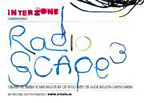
Mixing the City
In Radioscape III--a project by Edwin van der Heide--there are fifteen transmitters installed around and on the Leidseplein in Amsterdam, each broadcasting its own musical layer. Van der Heide designed a receiver that allows you to receive and mix the signals of two, three or more transmitters simultaneously. At a certain moment you receive one transmitter the strongest, the second a bit softer and the rest might be inaudible. By walking through the environment the balance between the transmitters is changing, new ones are fading in while others are fading out. Van der Heide: "The city centre forms a musical labyrinth with different layers of sound that, together, form a meta composition. By moving you mix the different layers which lead to new combinations and interferences."
Radioscape is open from Thursday the 28th of October till (including) Sunday the 7th of november. You can obtain a Radioscape receiver at the counter of De Balie. They can be fetched between 13:00 and 20:00
Radioscape is freely accessible for the audience. In order to borrow the receiver you have to deposit either 50 euro's or an id card. You have up to one hour to 'radioscape'.
Radioscape III is part of the Interzone series by De Balie, a series of artistic explorations crossing the borders between the existing artistic disciplines.
Posted by jo at 10:14 AM | Comments (0)
October 27, 2004
ArtFutura
![]()
Augmented Reality
ArtFutura's theme this year is Augmented Reality. It's taking place now in Barcelona [October 28th-31st]. The programme includes Howard "Smartmobs" Rheingold, Blast Theory who will perform Can You See Me Now?, the SimpleTEXT performance, Dublin’s MediaLab Europe and Montreal’s SAT will be showcasing installations and developing experimental projects, Richard Marks, creator of EYETOY, Greyworld, Fiona Raby, etc. (via)

Saturday October 30, 2004 - 4PM - 8PM, Live from Barcelona, SAT presents Phéromones, the Art Futura's closing show. Phéromones is a network multichannel audiovisual techno performance regrouping musicians Alain Thibault, Physical Noise Theatre & Champion and VJ jocool , Ladyroll & Le couple in Barcelona as well as Yan Breuleux, Nuclear Ramjet & Johnny Ranger in Montreal.
Pheromones will connect by means of an optical fiber network of Internet 2 (providing data flows of up to 2 Gigabytes per second) the Mercat de les Flors at Barcelona and the head office of the SAT at Montreal in order to share music and images generated on both sides of the world, by means of an experimental technical support: eight audio channels and immersive multi-screens. R&D for clubbing culture.
From October 26 to 30, 2004
A team of 17 artists, researchers and technicians, as members of the Territoires ouverts - TOT - Open Territories consortium initiated by the SAT, are invited by the Art Futura festival to present their work in Barcelona.
Several of the tools developed at SAT, like the nSLAM multichannel audio application and pixelTANGO digital video mixer, will be put at contribution in order to show the know-how and the expertise of the developpers in the fields of IP streaming video and mulitichannel audio, IP telepresence (point-to-point and multi-point) and transmission of immersive audio-visual environments over IP networks.
The Open Territories project aims to foster the emergence of innovative forms of cultural expression by engaging the creativity of a new generation of artists and creators, in whose hands will be placed a host of advanced interface and networking technologies. The TOT project will be able to open the broadband network environment to talented creators who are ideally placed to illustrate broadband's potential as a means of avant-garde cultural expression.
Thursday October 28, 2004 - 10AM - 5PM
Friday October 29, 2004 - 10AM - 5PM
Saturday October 30, 2004 - 10AM - 4PM
SAT invites you and your friends to "cross the Atlantic" and project yourself at the beautiful Mercat de les Flors in Barcelona, site of the Art Futura Festival.
During the three days of the festival, using two Telepresence stations, people at both side of the Atlantic will be able to meet and speak as if they were sitting on the same table, with high audio and video resolution.
To participate and meet the catalan artistic community, Art Futura's visitors and the SAT team in Barcelone, come at the SAT Café each day between 10AM and 5PM (4PM Saturday).
Free entrance
Posted by jo at 02:00 PM | Comments (0)
October 26, 2004
Touch Over Distance

Melt
Melt, by Slavica Ceperkovic and Nicholas Stedman, is a telematic installation in which the touch of a person in one country melts a block of ice in another. A table with embedded sensors registers the touch of installation visitors in France, which is then transferred and translated through the Internet and activates heat sensors embedded in a block of ice in Canada. The ice traces the presence of the visitors through melting and refreezing. The image of the ice can be seen via a live web stream projected in the space in France, so that the visitor can see their impact. This piece was installed with the sensor station at Le Fresnoy Studio National des Arts Contemporains in Lille, France, and the receiving station at the Banff Centre for the Arts, Banff, Canada. To see documentation stills and video visit the websites of Slavica Ceperkovic and Nicholas Stedman. (Posted by Michelle Kasprzak)
Posted by at 06:20 PM | Comments (0)
October 22, 2004
GilbertandGrape

Kiosk Correspondence
We'd like to invite you all to receive exclusive reports of GilbertandGrape's whereabouts at the Rogaland Kunstsenter, Norway and the Vlepo Gallery, NY. The performance can also be partly viewed online. GilbertandGrape will be staked out in a red phone kiosk by the pier on the west coast of Norway between 5pm and 7pm on October 25th, 2004. GilbertandGrape will call the Rogaland Kunstsenter from the phone kiosk every 15 minutes and upload a photograph from this moment to their website.
Kiosk Correspondance is a sub plot of the GilbertandGrape performance Lone Ranging Romance. Between 2004 and 2008 GilbertandGrape and their lone ranger, a 20 kilo stuffed moose head, will travel the coasts of England and Norway in a Volvo Amazon to search out and collect stories from people with an interest in nostalgia, document vague memories, exchange taped music that has romantic significance, and at the end of the day watch the sun set together with the people we've met. For more information on Lone Ranging Romance see our website. Love and Scandal, GilbertandGrape
Posted by jo at 03:53 PM | Comments (0)
October 20, 2004
Geostash
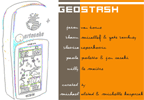
Hide, Seek, Act
Geostash is a public art project that uses the city of Toronto as its inspiration and utilises Global Positioning Technology (GPS) and the web as a means to achieve its creative goals. Geostash takes its cues from the practice of Geocaching (blogged here) - a sort of high-tech treasure hunt that was originally conceived in 2000, and has spread worldwide through websites promoting this activity. Each artist will hide a "stash" somewhere in the city and post the GPS co-ordinates of where the stash is hidden on the Geostash website. The stash may contain a set of instructions requesting an in-situ performance, or could contain objects, materials and a manual to create temporary public art. Once the stashes have all been placed in the city, each participating artist will be randomly assigned another artists' stash to find using a GPS receiver. Once found, the artist will transform the contents of the stash into a performance or ephemeral work of public art.
Date: October 29 - 31, 2004
Location: Various locations in Toronto TBA (check blog for updates)
Participating Artists: Jason Van Horne + Duncan Walker, Shawn Micallef
+ Gabe Sawhney, Slavica Ceperkovic, Paola Poletto + Jon Sasaki, Willy
Le Maitre
Curators: Michael Alstad & Michelle Kasprzak
Posted by newradio at 09:35 AM
October 19, 2004
Teri Rueb

Connecting via Fluid Space
"The integration of data space and real space through mobile media and location-based systems brings back into circulation a whole host of communication rituals and interaction styles that engage the body, movement and context-sensitive exchanges. With the increasing ubiquity of wireless and mobile media, space is imagined as a Hertzian soup – a space of flows that defies the clear and fast boundaries of visual space and concrete form, instead emphasizing our connectedness in and through the social body." Continue reading Syncopated space – wireless media shaping human movement and social interaction by Teri Rueb.
As a digital artist, Teri Rueb explores the relationship between sound, space and human movement in location-aware installations and large-scale responsive spaces. She exhibits and lectures widely in international venues and is a professor in the graduate Department of Digital Media at the Rhode Island School of Design (RISD).
Posted by jo at 08:30 AM | Comments (0)
October 15, 2004
Love One Day

Time, Space, Love
'love one day' was a real one-off action through time and space, presented live online and later as a cinematic video installation. Two people from two distant parts of the UK started a long journey to London. They met in a hotel bedroom and within 24 hours of starting their journey, they left. 'love one day' explored the communication between two people whose anticipation of love was heightened by the unique circumstances of their journey. It documented the emotions, thoughts, observations and behaviour of two 'matched' individuals as they traveled towards each other and met one day. 'love one day' investigated psychological motivations, how we communicate and interact with others and how we are affected by our environment, space and time.
A unique 'love one day' dating website was created. This allowed people to submit their personal profile and browse/chat amongst other candidates looking for the perfect match during one month. The website took on a similar format to that used by online dating agencies with specific questions designed to recruit two protagonists for a journey to meet in London. 'love one day' was publicised and promoted through online listings, press and 'satellite venues' (public spaces and institutions supporting the project) as well as the website's established visitors and target audience.
Two people from a selection of 'matched' couples via the 'dating website', were interviewed and chosen to become the main protagonists of this experience. People prepared to accept the role of protagonist by embarking on an emotional and physical journey to meet someone they have never met in a hotel bedroom were sought. They were chosen on the basis that they made a good love match.
The two selected protagonists were each given a mobile phone to continue their communication by phone, in text and images so they could get to know one each other a little more before their journey started. No direct contact was allowed until they met for the first time in the hotel during filming. The entire journey was filmed and the telecommunications were documented live on the love one day website. The protagonists later met with a relationship psychologist to feedback about their experience.
'love one day' is a project of completely naked.
Posted by jo at 01:01 AM | Comments (0)
October 13, 2004
CITYchromosomes

Fixed Points Gathering Impressions
The Stadschromosmen (CITYchromosomes) project gathered thoughts and impressions of particular points around Antwerp and its districts that were shared via SMS. There were 25 ‘text points’, each inviting the submission of impressions about that place. After six months, a selection has been compiled into a booklet that combines the different ‘text points’ and gives an alternative view on Antwerp and its districts. The booklet (in Dutch) is available for download in PDF, plain text and a special version for iPods. By November 15, a complete English translation will also be available under the creative commons license.
"It’s been a fantastic, city-wide...event, put together against the odds and with very little support...by Stefan Kolgen and Ann Laenen of C.H.I.P.S, and including brilliant things like them spending a night turning all the city’s buses into Stadschromosomen text points and leading a walk with 200 recent immigrants round the city, asking them to text in their feelings about the landmarks of their new home town." FishArePeopleToo
STADSchromosomen is CityPoems’ sister project in Antwerp, Belgium, UNESCO's World Book Capital 2004. CityPoems and STADSchromosomen have 'twinned' matching locations in Leeds and Antwerp, to let you use your mobile phone to be in two cities at once.
Posted by jo at 03:05 PM | Comments (1)
October 11, 2004
Platfrom

Routed Narratives
Platfrom, by Rachel Baker, uses the platform of the mobile phone within a very specific context - the train journey. A series of playful SMS messaging scenarios will make a relation between mobile phone and rail network as communication systems. Focusing on privatised, proprietary networks -the railway and the mobile phone -the project will invert them into opportunities for public and group interaction. It offers moments for train culture and SMS culture to integrate, taking advantage of a journey's incidental nature (delays etc.) with unknown consequences by creating a common gateway between train traveller and static web user and including them both in a narrative along a particular route. The narrative at this stage is dictated by the route from South to North and the contiguous cities and landscape. Read more [PDF]. Also read an essay by Matt Locke.
Posted by jo at 11:52 AM | Comments (0)
October 06, 2004
Organised Sound: An International Journal of Music and Technology

Networked Music
Interconnection has always been a fundamental principle of music, prompting experimental artists to explore the implications of linking their computers together long before the Internet reached the public consciousness. As the Internet achieved critical mass over the past decade, networking technology took centre stage as the key to a vast new territory of possibility, facilitating remote participation, distributed processing, and redefinition of musical space and time. The Web emerged as a virtual venue for countless musical purposes, and as analog acoustics transformed to digital representations, packets of data carried by IP from one address to another became a modern metaphor for air molecules transmitting the tone of vibrating body to eardrum.
As with any new technology, applications of networking to music have evolved from naïve proofs-of-concept to more sophisticated projects, and we stand now at a point when 'internetworking' is taken for granted, novelty is expiring and artistic goals more often transcend technical considerations. From this vantage, the essential question is not how networking and music are combined, but why. What is the unique experience that can be created? Whose role can be empowered or transformed: composer, performer, audience? Where can sound come alive that it couldn't otherwise? Networked music can reinterpret traditional perspectives on stagecraft, ensemble, improvisation, instrumentation, and collaboration, or enable otherwise impractical relationships between controllers, sensors, processors, inputs, and outputs. The network can be an interface, a medium, an amplifier, a microphone, a mirror, a conduit, a cloud, or a heartbeat.
The network is all of us. Music is the sound we make. Listen...
Call for Articles and Works
Volume 10, Number 3
Issue thematic title: Networked Music
Date of Publication: December 2005
Publishers: Cambridge University Press
We invite submissions from composers, performers, artists and researchers working in the realm of digital media and sound. Submissions related to the theme are encouraged; however, those that fall outside the scope of this theme are always welcome.
Issue Co-ordinators: Margaret Schedel [gem at schedel.net] and John P. Young [sound at netmuse.org]. This issue is being prepared in collaboration with the International Computer Music Association (ICMA).
The theme represents many avenues for discussion including, but not limited to:
Networked control interfaces (hardware/software)
Sensor arrays/interaction
Distributed/remote participation (composition, performance, reception)
Broadcasting/multicasting/streaming media
Virtual musical environments/venues
Aesthetics/philosophy of musical interconnection
Web-based music projects
OpenSoundControl
Distance learning/education
Online collaboration
Networked data sonification
Real-time remote sensing
Distributed processing
Networking for fault tolerance
Musical avatars/agents/bots
Emergent network phenomena/effects/behavior
Neural networks
Internet2
Alternative musical networks (RF, MIDI, WiFi, Bluetooth, etc.)
Strategies for mitigating network limitations (bandwidth, latency, etc.)
This issue continues the annual partnership between Organised Sound and the International Computer Music Association, with previous themes including "Performing with Technology" and "Collaboration and Intermedia." In exploring these prior areas, networking has emerged as a common element underlying a wide variety of innovative projects, prompting a more focused look at the mutual influence between networks and music. This should be no surprise in the electroacoustic field, where our machines are partners as much as tools, and working with other artists or often even solo requires connection between multiple machines. In the pre-network era, technical obstacles frequently dictated that much computer music occurred in relative isolation, with musicians expending precious attention acting as interpreters between hardware and other humans. So in one sense, networked music can be simply a recapitulation of acoustic music principles, of listening and sensitivity to other performers and audience, by enabling computers to participate equally in the musical conversation. Networking can also radically alter these traditional principles, most obviously by decoupling the spatial framework, enabling some or all of the participants to act and perceive without being physically present. Thus networked music is fertile territory for the composers, performers, and researchers that comprise the ICMA as both a potential means of overcoming challenging limitations of technology, as well as presenting new possibilities we have yet to imagine.
Submissions may consist of papers, with optional supporting short compositions or excerpts, audio-visual documentation of performances and/or other aspects related to your submission. Supporting audio and audio-visual material will be presented as art of the journal's annual DVD-ROM which will appear with issue 10/3. Related discussion will be located on the ICMA Array website, and additional multimedia at Organised Sound's Cambridge University Press website.
SUBMISSION DEADLINE: 1 March 2005
SUBMISSION FORMAT
Notes for Contributors and further details can be obtained from the inside back cover of published issues of Organised Sound or from:
http://uk.cambridge.org/journals/oso/
Email submissions should be sent to (please see SUBMISSION FORMAT above): os at dmu.ac.uk
Hard copy of articles (only when requested) and other material (e.g., images, sound and audio-visual files, etc.) should be submitted to:
Prof. Leigh Landy
Organised Sound
Clephan Building
De Montfort University
Leicester LE1 9BH, UK.
Editor: Leigh Landy
Associate Editors: Ross Kirk and Richard Orton
Regional Editors: Joel Chadabe, Kenneth Fields, Eduardo Miranda, Jøran
Rudi, Barry Truax, Ian Whalley, David Worrall
ICMA Representative: Mary Simoni
International Editorial Board: Marc Battier, Laurant Bayle, Hannah Bosma, Allesandro Cipriani, Simon Emmerson, Rajmil Fischman, David Howard, Rosemary Mountain, Tony Myatt, Jean-Claude Risset, Francis Rumsey
Posted by jo at 09:27 AM | Comments (0)
September 28, 2004
DENSITY Bus Tour

Sound in Motion
DENCITY is a live performance of electro-acoustic music on a nightly bus tour through New York's hidden landscapes. It is the contemporary urban equivalent of an explorer's notebook- a kind of Huck Finn on land. The producers of the DENCITY project are interested in exploring the relations between our point of departure, Williamsburg and some of the surrounding neighborhoods that have remained on the periphery of most experiences of NYC.
Rather than guide you through these spaces as a standard tour would, your "tour guides" will navigate you through these spaces with sound that is generated on the bus and sounds that have been collected "on site". Your audio "tour guides" will be Heimo Lattner and Erin McGonigle. Two artists who have significant experience performing in a variety of contexts/spaces. They, along with Rene Gabri, have also composed s route that they hope will stimulate new or interesting questions about these peripheral spaces. Read an interview.
DENCITY can be seen as a point of entry into these spaces. The artists involved create a "public" project and a "social" space that provokes the "tourist" or traveler to ask questions about the significance, history, and relationship of these spaces to the spaces they/we normally occupy and navigate through in the City. They also create a context in which the very act of "touring" is both an answer and a question. Sound, architecture, landscape and this tour bus are the forms that will open up these lanes of exploration.
Posted by jo at 03:06 AM | Comments (1)
September 23, 2004
ACCESS
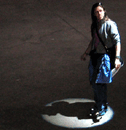
Undesired Spotlight
ACCESS is a public art installation by Marie Sester that applies web, computer, sound and lighting technologies in which web users track individuals in public spaces with a unique robotic spotlight and acoustic beam system. The robotic spotlight automatically follows the tracked individuals while the acoustic beam projects audio that only they can hear. The tracked individuals do not know who is tracking them or why they are being tracked, nor are they aware of being the only persons among the public hearing the sound. The web users do not know that their actions trigger sound towards the target. In effect, both the tracker and the tracked are in a paradoxical communication loop. The ACCESS spotlight system travels from one undisclosed public space to another. The exact location of the public space is revealed only after ACCESS moves to its next location. The ACCESS website, which contains the webcam view and spotlight control, keeps an updated list of the locations visited as well as a video archive. Click here to participate.
Regine blogged this on we make money not art
The content of ACCESS calls for awareness of the implications of surveillance, detection, celebrity, and their impact on society. The structure of ACCESS is intentionally ambiguous, revealing the obsession/fascination for control, visibility, and vigilance: scary or fun. ACCESS was primarily influenced by the beauty of the surveillance representations (x-rayed bodies, luggage or vehicles, 3D laser scans, satellite reconnaissance imagery, etc.), the invisibility of the collected data, and the power generated by means of surveillance practices.
Posted by jo at 07:30 AM | Comments (0)
September 21, 2004
Free phone booth at Burning Man
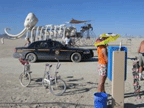
Connected to Nothing and Everyone
Burning Man deliberately takes place in a harsh, remote location. Each year, 30,000+ people gather and build a city of art on the flat playa of the Black Rock Desert in northern Nevada, then dismantle it a week later--to the point that after cleanup, you can't even tell it was there. It's an environment devoted to being appreciated, commerce-free--about art and technology and shared experience.
The Black Rock Desert is where the rocket cars broke the sound barrier. It's a perfectly flat dry lakebed, the location miles from the nearest village of Gerlach, and about 90 miles from Reno, the nearest significant city. In other words, it's about the last place you would expect to find a phone booth, which is why I had to build one. Ideally I wanted a traditional "superman" style booth, and those can be found, but cost a fortune to ship, so we went with a more modern pedestal style phone. The goal was to have the phone just sitting there, mounted on the desert floor, connected to nothing, yet working, just where it shouldn't.
Posted by jo at 02:20 PM | Comments (1)
Life: A User's Manual
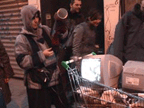
Subverting Surveillance Tactics
Life: A User's Manual is a public performance by media artist Michelle Teran where she dresses up like a bag lady and carries an antenna made out of a soup can while pushing a shopping cart full of televisions along a designated route in Brussels, Belgium. The antenna is connected to a 2.4 GHZ X-10 video scanner which picks up signals from wireless cameras deployed by stores, homes, or police in the buildings and neighborhoods she passes. The found signal is then displayed on the TV in her cart. This type of surveillance is a theme of Teran's work that attempts to make hidden or private CCTV streams into public performance and online mappings. Really interesting take on the act of subverting existing surveillance tactics by displacing the context of the medium.
From her description: “The city is a game board, where every story, every piece stands on its own, but is part of an intricate jigsaw puzzle. Both public physical spaces and private interior spaces contain traces of fragmentary personal [hi]stories tied together by an invisible network of media. How people inhabit the hidden ‘image spaces’, discovered by a wireless surveillance camera scanner, while at the same time inhabiting physical outdoor spaces, is revealed through the practice of walking.” From jonah at coin operated.
Posted by jo at 07:39 AM | Comments (1)
September 12, 2004
mobile performance group
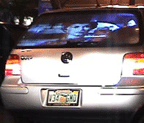
(auto)mobile performances
04.15.04 Downtown Orlando FL: Using the automobile as a mobile performance apparatus MPG presented a live performance which included real-time video and audio processing techniques. This project used two cars, one with audio performers the other with video performers. Using wireless networking and a FM transmitter the two cars where able to keep in sync and perform together as they moved through the city. Performers where Laura Oxendine, Adam Roberts, Martha Garzon, Damion Waters, Bryan O'neal, Ben Hustis, Julius Santiago, James Auten, Chester Udell, Jamie Tauler. Project Leaders where Nathan Wolek, Matt Roberts.
MPG:Mobile Performance Group is a collective of new media artists interested in finding new ways to present art outside of traditional venues. The Group was founded by Matt Roberts and is based in Florida. Using custom video and audio software instruments in real-time, and original video and audio recordings, Roberts and Wolek will present a meditation on the Florida Landscape which will be realized as an improvised new media performance at the New Forms Festival, Vancouver, Canada on October 24, 2004.
Posted by jo at 04:46 PM | Comments (0)
September 02, 2004
M@ggie's Love Bytes
theater that dares
M@ggie's Love Bytes is a dance theatre performance ocurring in real and virtual (net) space. Participants - M@ggie and her lovers - interact through sound, text, and realtime video conferencing via the Internet. Love Bytes are given to M@ggie in the form of digital signals. The hardcore performance group consists of a choreographer, two musicians and three dancers.
This is a post-modem project, using the Internet as a platform for interaction. The restrictions of the chosen technology are used as an expression of Now! This project focuses on connection and disconnection, appearance, disappeareance and reappearance. Fluctuations in transmission and reception rates between the geographically separated participants are embedded in the expression of the performance, and define the dramatical development of the piece.
M@ggie is represented physically by three dancers, each dressed in bra and pants and equipped with a plunger. M@ggie relates strongly to the soundscape. M@ggie's lovers enter the performance from such diverse locations as Cologne, Yokohama, London, San Francisco and Copenhagen.
While some remote participants are regularly active as collaborators (musicians and dancers who are involved in rehearsals), others enter the project for the first time during performance. You'll find a downloadable RealVideo (494k) introduction to M@ggie HERE which'll give you more of an idea about who she is :)
Each participant is free to choose their own form of interaction. Each remote participant experiences their own unique performance on their computer desktops and in their local spaces - some choose informal party settings, others create their own scenic settings inviting their own audiences. In addition to the live interactioin described above, audio and visual gifts from visitors deposited in M@ggie's Giftbox, are integrated into the performance. By using several interwoven physical and virtual platforms for interaction, a multitude of simultaneous telephonic spaces occurs between the diverse physical locations.
Here is a review from the show @ Electra, march '96.
Posted by jo at 06:49 PM | Comments (0)
ILoveBees Breaks Into the "Real World"

Beekeeping Mobs
Posted by vpisteve at 11:27 PM on Alternative Reality Gaming Network: August 24, 2004. It all began at 6:07 am PDT. Payphones from coast to coast began to ring. A twelve-hour wave of carefully planned phone calls began to sweep the country, and Halo fans, Beekeepers, the Media and the just plain curious were there to try to intercept them.
This morning, we got to find out what was in store for those who were following the events of Dana and the rogue AI attacking her aunt's website. While many were expecting Halo 2 demo disks, what they got instead was one of the largest, most complicated distributed interactions in ARG history. Hundreds of people around the country descended upon over 200 locales, working as a team to answer phone calls correctly, in order to unlock a series of audio clues.
While we don't have the space here to go into the story itself (for that, check the links below), here's how the whole thing worked: Players were presented with a web page that listed 30 blocks of seven GPS coordinates, which turned out to represent payphones around the country. Each location had a specific time attached, and each block of seven locations had a common password. As the phones started ringing at the exact corresponding time, players realized that they must respond correctly to the voice on the other end in order for something to happen. It was determined that players needed to provide the nickname for the AI that was calling them, plus the password listed for their location. If successful, the web-page immediately updated, indicating success. Two successful responses per group of seven then resulted in an audio file being unlocked. Players successfully unlocked 22 of 30 files the first day, with another chance to unlock the remaining ones every 24 hours. These audio files, when assembled, are revealing a fascinating story.
And this is only the beginning!
Forums and IRC channels broke all records today. The main chat room, #beekeepers, peaked at over 300 users at one point. In addition, the press is taking notice of what's going on. Word is that G4TV's Pulse will be airing a story about ilovebees this Friday, so stay tuned.
Here's a video of one event in Georgia. (6.7 MB)
Unfiction Ilovebees Forums
Guide
Quickstart
Wiki
Chat
Plot Timeline
Photo credits
Berkeley: Stitch
Burbank: MrBabyMan
See also This Week in ARGs: Flash Mobs of Beekeepers?? and I Love Bees.
Posted by jo at 10:27 AM | Comments (2)
August 30, 2004
Benoit Maubrey
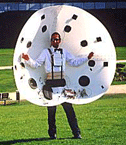
strutting and projecting his stuff
AUDIO PEACOCK is the most recent performance by Benoit Maubrey (2003). These wearable electronic instruments are constructed from polycarbonat plexigalss material shaped into a peacock's fan-like plumage. The plexiglass surface is equipped with 16 loudspeakers (150 watts power), amplifiers, and rechargeable 12 volt batteries. The "audio-plumage" is highly directional and functions like an electroacoustic radar dish--esthetically it has much in common with the way a peacock parades itself in front of the pea-hen (the audience). An Audio Peacock can either amplify its own electronic instrument and voice or receive sounds from outside sources via transmitter/receiver and disseminate them in a space by orienting his high-tech "plumage." Four Audio Peacock units can be acoustically choreographed as a mobile quadrophonic loudspeaker system.
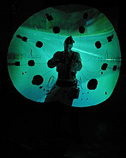 VIDEO PEACOCK: An Audio Peacock costume (constructed from white polycarbonat-plexiglass) is used as a mobile projection screen. This is a solo audio-visual concert where the electro-acoustic quality of an Audio Peacock is visually enhanced via a video beamer: moving images (both live and recorded) can be projected directly onto the performer's costume. A story is told "live" by a figurant who simultaneously samples his own amplified voice, manipulating the sound (loop and pitch): the performer dubs his own hallucogenic dream. View video (33.4 MB, Quicktime)
VIDEO PEACOCK: An Audio Peacock costume (constructed from white polycarbonat-plexiglass) is used as a mobile projection screen. This is a solo audio-visual concert where the electro-acoustic quality of an Audio Peacock is visually enhanced via a video beamer: moving images (both live and recorded) can be projected directly onto the performer's costume. A story is told "live" by a figurant who simultaneously samples his own amplified voice, manipulating the sound (loop and pitch): the performer dubs his own hallucogenic dream. View video (33.4 MB, Quicktime)
See a brief history with images of Maubrey's work.
Posted by jo at 02:00 PM | Comments (0)
August 14, 2004
FurtherStudio
real-time, online digital/net art residencies
furtherfield's furtherstudio is a unique artist residency, where our hero (the artist) is being watched, online in real-time, by viewers, critics, and other artists alike. Said viewers can respond to, critique, evaluate, discuss, and even collaborate with the artist-in-residence, whose completed, and in-progress, work is always available, and in flux.
So far, artists include Jess Loseby, Rich White, and now, replic**t. Admittedly, the visitor's studio is a bit confusing, but my guess is that this may be from a combination of a lot of use and uploading, and South African bandwidth issues...
Posted by at 11:05 AM | Comments (0)
August 13, 2004
front - I know you wanna

who is rubber and who is glue?
front, by Ralph Borland (South Africa), Jessica Findley and Margot Jacobs (both USA), consists of two performance suits, each with 'offensive' and 'defensive' inflatable air sacs. After suiting up over their own clothes, the two participants have a bit of a screaming match. Hidden microphones pick up the amplitude of their screams, and the battle begins. The suit of the performer who is louder (at any given time) will have offensive parts (like horns) that inflate, and defensive parts (like a constrictive neckpiece) that deflate - his or her opponent's suit will do the reverse.
Aside from the obvious performative strength behind sheer volume, and the animal-like battles that often arise from front, I can't help but wonder how this might work on a large scale. Who is to say these suits can't speak over a longer distanced network; what, where or who else could we effect? Where can I get a pair of these for my next poetry slam? Talk about blowing up in an argument....(Posted by Nathaniel Stern)
Posted by at 08:34 AM | Comments (0)
August 02, 2004
Pedestrian Cinematic Experience
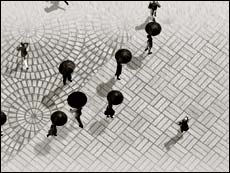
Pedestrian by Shelley Eshkar and Paul Kaiser
February 13 - March 23, 2002:
Pedestrian is a public art project of site-specific, projected installations presented simultaneously in three locations in New York City - in the galleries at Eyebeam in Chelsea and at two outdoor venues; at Rockefeller Plaza in Midtown, and The Studio Museum in Harlem.
Created by artists Shelley Eshkar and Paul Kaiser and co-produced by Eyebeam and Art Production Fund, Pedestrian presents miniature, computer-generated moving figures projected directly onto the ground from above, providing a bird's-eye view of pedestrian traffic. These projected "pedestrians" interact to form patterns, crowds and streams that evolve unpredictably, almost organically, as if having lives of their own. Figures stand, watch, meet, sit, push, move away, sometimes run, or perhaps even lie down according to spontaneous rules of motion and engagement. Pedestrian builds on advanced technology, combining motion-capture, 3-D modeling software, texture mapping to visually enrich surface detail, behavioral rules devised by the artists to drive the action, and an overarching cinematic framework.
Pedestrian depicts a solid and almost tactile world within the pavement you walk upon. It's medium is that of a projected image directly onto the pavement. Instead of a sober rectangle, spectators form a dynamic human perimeter around the work. These are conscious choices to emphasize the work's physicality, and to have our own presence essentially complete the artwork; we and Pedestrian generate a unique crowd footprint in the real world.
By projecting Pedestrian onto public sidewalks, the artists experiment with cinematic experience in the context of public sculpture. Viewers see a bird's eye view of 3D modeled plazas and figures that are mapped with texture samples gathered and scanned from the real world. All movement is built from a library of motion-captured data that is mapped onto synthetic characters. The final projection shows a miniature depiction of real - life motions and the daily public interactions of figures representing various urban archetypes. The distorted foreshortening of an aerial perspective of doll-like figures and plazas are suggestive of surveillance or video games in which we play out constantly changing narratives and dialogue that will continue outside of our current viewpoint
Featured in the ZKM book Future Cinema.
Posted by michelle at 11:19 AM | Comments (0)
July 30, 2004
On Liveness and Presence
What is Live Art?
This from the UK: "Unlike with opera, people often ask, 'What is Live Art?' The answer is people have been experiencing it for the last hundred years, from the earliest events at the Cabaret Voltaire where DADA was born to the happenings of the Sixties which influenced Andy Warhol, and in the 21st century this tradition continues to mutate." 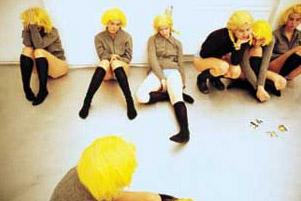
Today Live Art is witnessed at perfomances by Vanessa Beecroft or The Battle of Orgreave by Jeremy Dellar. Live Art is an interrogation of the aesthetics of presence. Live Art is about being there.
"Live Art mixes genres and diverse cultural experiences to express the complex organisation of contemporary life. It often involves work which questions commonly held assumptions. Live art is the trash-can of culture recycling and celebrating the debris of the modern world."
The History
: In 1965 Kaprow explained his evolution from collage to environments and happenings: "The action collages then became bigger, and I introduced flashing lights and thicker hunks of matter. These parts projected further and further from the wall into the room, and included more and more audible elements: sounds of ringing buzzers, bells, toys, etc., until I had accumulated nearly all the sensory elements I was to work with during the following years...." His works expanded until they filled the gallery, creating an integrated environment for the spectator. "I immediately saw that every visitor to the environment was part of it. And so I gave him opportunities like moving something, turning switches on -- just a few things. Increasingly during 1957 and 1958, this suggested a more 'scored' responsibility for the visitor. I offered him more and more to do until there developed the Happening...The integration of all elements -- environment, constructed sections, time, space, and people -- has been my main technical problem ever since."
Kaprow's progress did not occur in a vacuum, as he readily acknowledges. Robert Rauschenburg, Claes Oldenburg, and Jim Dine, among others, were also working on theatrical pieces, although they soon returned to more traditional areas; In Europe, Wolf Vostell and the Fluxus Group, and in Japan, the Gutai Group, were all investigating similar directions.
The Theory of Happenings: The Happening, as Kaprow developed it, is a non-verbal, theatrical production that abandons stage-audience structure as well as the usual plot or narrative line of traditional theatre. Although a compartmented organization may be used, the performers are considered as objects -- often kinaesthetically involved -- within an overall design of environment, timing, sound, colour and light. Found environments are often used and built upon, but the events are not casually arrived at, nor are they entirely accidental and spontaneous.
His view was that the Assemblage was to be "handled and walked around", the environment" was to be "walked into", but the happening was to be a genuine "event" involving spectator participation and no longer confined to the museum or gallery. Performers are encouraged to capitalize upon unplanned occurrences while acting out fantasies based on real life within a certain roughly pre-ordained structure that suggests symbolic and universally basic themes and meanings. A field of aesthetic operation is thus created in relation to life, combining artfully determined materials with strong associational properties, and dimensions with events and things from the sphere "outside" of customary definitions for art.
In the following networked performance types we directly see the influence of happenings particularly in the emergence of wireless network enabled Urban Gaming such as the Go Game. Go Game started off as a bunch of digerati having fun with their handhelds. Then it started becoming popular so the developers began marketing their services as event producers to corporations. Now their website has this decidedly corporate slant.
Pac-Manhattan was developed out of the NYU Interactive media program...possibly interesting if it doesn't fizzle out....
Urban Challenge, urrr I guess it's now Verison Urban Challenge. Enough said.
FlashMobs have matured to smart mobs.
GeoCaching is an entertaining adventure game for GPS users. Participating in a cache hunt is a good way to take advantage of the wonderful features and capability of a GPS unit. The basic idea is to have individuals and organizations set up caches all over the world and share the locations of these caches on the internet. GPS users can then use the location coordinates to find the caches. Once found, a cache may provide the visitor with a wide variety of rewards. All the visitor is asked to do is if they get something they should try to leave something for the cache.
Posted by michelle at 11:40 AM | Comments (0)

